Country









By Jon Rawlinson
The alarm has been sounded, with full lights and sirens, but it appears Te Kūiti’s ambulance service will survive, albeit operating from a new base of operations.
As this edition went to press, St John was poised to deliver its prognosis at a meeting scheduled for yesterday (Wednesday).
The fate of the service had been in doubt with a plan touted to move the town’s only ambulance to Te Awamutu. It would then be driven to Te Kūiti each morning.
Although Mark Quin from the NZ Ambulance Association concedes that it’s impossible to predict, he argues against such a move.
“Having worked in the service for 25 years, I think the community may suffer,” he said. “I’ve put a submission in and told them my thoughts – not to [relocate] because it’s another resource out of the community, it’s another resource gone that you’ll never get back.”
Waitomo mayor John Robertson
said St John had promised him that whatever changes were made would not decrease the service level in the district.
“The way they described it to me was that it will be driven down from Te Awamutu each morning, first thing. That was a proposal, which I suspect they’ve been consulting on.”
St John staff members were notified of the proposal last month with a timeline for consultation and feedback. A document sent to staff outlines the plan which suggests changes from March 31.
“With the proposed move to start and finish the Te Kūiti vehicle from Te Awamutu station, the vehicle will immediately travel to Te Kūiti to be based there,’ it says.
“Forty-five minutes from the end of the shift it will… travel back to Te Awamutu station to end its shift.”
Difficulty recruiting people to be based in Te Kūiti is given by St John as the reason behind the move.
‘Recruiting is harder to achieve in the more geographically remote areas… Historically and typically,
the majority of staff who cover the Te Kūiti roster do not live in, or near, Te Kuiti and they are travelling considerable distances to commence their shift[s]”.
‘We believe this change will greatly enhance recruitment and retention for this roster which serves and benefits the Te Kūiti community… Te Awamutu will be more accessible/attractive to a greater number of staff to provide additional shift cover during roster gaps.”
Keith Buswell, from Te Kūiti Medical Centre, has previously substantiated claims that St John has struggled to fill roles locally. But he contends that relocating the ambulance is not the answer.
“We know there are issues around recruiting staff who are willing to live in rural areas like Te Kūiti, but we would be very concerned if the regular ambulance service was removed from town,” he said at the time. “It would have a significant impact on response times from the ambulance and would compromise patient care.”
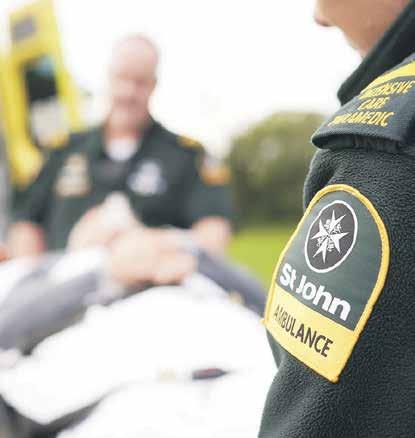
Speedy assistance ensured a fleeing duo ran out of road on Valentine’s Day.
A man and woman from New Plymouth who were in car spotted driving dangerously in Te Kuiti were eventually brought to a halt… 80km away in central Hamilton. But only after a lengthy case of police playing follow the leader.
The driver of the car ignored requests to stop after being reported in Te Kūiti, drove over several sets of road spikes in Ōhaupō
and Glenview, Hamilton, then led police on a low speed parade before stopping in central Hamilton.
“A Subaru vehicle was driving dangerously and overtaking vehicles through roadworks in Te Kūiti,” Senior Sergeant Leo Belay from Waikato Police said.
“After being located and signalled to stop, the vehicle fled but was not pursued. It continued to drive in a dangerous manner towards Hamilton, where more members of

the public called to report erratic driving.”
After being spotted by police in Te Awamutu, an unmarked car followed. Road spikes (TDDs), used in Ōhaupō, punctured any hopes of a clean getaway.
“The vehicle continued toward Glenview in Hamilton, where TDDs were successfully deployed a further four times in quick succession. Police then “engaged” in a lowspeed pursuit of the vehicle into Hamilton.”
The vehicle was eventually stopped on

Tristram Street where two people, both from New Plymouth, were taken into custody.
A 30-year-old woman was reportedly “assisting with enquiries” while a 33-yearold man faces charges including dangerous driving, aggravated failure to stop and driving while disqualified, Sgt Belay said.
“This event demonstrates the importance of reporting dangerous driving behaviour and the assistance it provides to police,” he said






















Ōtorohanga 07 873 6385 Te Kūiti 07 878 5169 Taupō 07 378 8545
www.actionelectrical.co.nz
The Waikato region’s bid to unlock central government funding and resources will be an investment in the future growth of New Zealand’s central and upper North Island.
A so-called ‘light touch’ regional deal proposal, developed by Waikato Regional Council under guidance from a Chief Executive Working Group, has been agreed by the Waikato Mayoral Forum.
government a cohesive and aligned package to drive economic growth, ensure quality and affordable homes are built where they’re needed, and we have resilient and connected rural communities,” the chair of the Waikato Mayoral Forum, Hauraki District Mayor Toby Adams, said
Council Chair Pamela Storey said the light-touch proposal recognises that Hamilton’s growth is fuelling, and being fuelled by, a growing region.
“And it demonstrates how investment in the Waikato is an investment in the powerhouse of New Zealand, with the benefits extending beyond our region due to our central location in the golden triangle with Auckland and Tauranga, and the North Island.”





Providing transport to medical and health related appointments.
Call our local office to find out more: 0800 846 9992 or email wakaora@stjohn.org.nz
Hato Hone St John’s purpose:
To make life-changing differences with our communities Ka
tātou i te pikinga o te ora
News/Editorial
Roy Pilott editor@goodlocal.nz
027 450 0115
Chris Gardner chris@goodlocal.nz
027 231 7007
Mary Anne Gill maryanne@goodlocal.nz
021 705 213
Viv Posselt viv@goodlocal.nz
027 233 7686
Advertising Director
Janine Davy janine@goodlocal.nz
027 287 0005
Owner/Publisher
David Mackenzie david@goodlocal.nz Office
07 878 1188 reception@goodlocal.nz
The proposal will be lodged by the Government’s 28 February deadline.
Regional Deals is the government’s initiative for establishing longterm agreements between central and local government. The programme unlocks funding and resource opportunities to support councils to make improvements in their region, for example to roads, infrastructure and the supply of quality housing.
“We have come together as a region to present to the
“The benefits of central funding and resource investment will ignore boundaries, turbo-charging economic growth in the whole region. To do this, we’ve had to prioritise projects that deliver regional benefits.
“Our regional deals proposal centres on an integrated, connected, highly mobile region where people and products move freely to markets,” Adams said.
Prioritised projects focus on the deal objectives: building economic growth, delivering connected and resilient infrastructure, and improving the supply of affordable and quality housing.
Waikato Regional
She said the Waikato region was strategically placed in the central and upper North Island, delivering goods, services and infrastructure that strengthen the national economy and deliver quality regional communities at both a metropolitan and provincial scale.
The existing and planned projects in the proposal will bring a range of benefits for the Waikato region, such as well functioning urban developments, significant job growth and housing supply, improved resilience on key transport
corridors, more resilient communities, efficient freight networks, reduced greenhouse gas emissions, improved tourist experiences, increased electricity generation, economic diversification and certainty of water supply.
Key projects include:
• network improvements to support the Roads of National Significance, including Southern Links, Cambridge to Piarere expressway extension and SH29 Tauriko West project.
• support for the golden triangle road and rail investment programme
832734 to schedule an appointment to see us
By Jon Rawlinson
When the chips are up (and flying), Taumarunui’s Jack Jordan is expected to, yet again, cut the competition down to size during the annual Rural Games in Feilding next month.
The Timbersports world champ will be going for glory as the pride of the country competes in a diverse range of events, from the traditional to the avant-garde, including speed shearing, fencing and harness racing, as well as gumboot and cowpat throwing just to name a few.
However, unlike most of his counterparts, Jordan is up for more illustrious honours as a finalist in the New Zealand Rural Sports Awards, held as part of the festivities.
“This year’s nominations set a record for athletes and contributors,” convenor of judges, Paul Allison, said.
“The awards play a vital role in

• delivery of the Future Proof priority development areas package, with a suite of initiatives including the Huntly wastewater plant, Ruakura, north Waipā/southern Hamilton, Hamilton central city.
• support for growing rural centres programme, for example in Paeroa, Putāruru, ThamesCoromandel, Matamata
• construction of resilient transport corridors for rural communities through the ThamesCoromandel Resilience Programme, on SH3 to Taranaki and SH1 Taupō to Desert Road
• infrastructure that supports tourism destinations
• investment in solar, wind and bioenergy
• water security.
celebrating the outstanding achievements of rural sportspeople, from competitors excelling in their fields to those working tirelessly behind the scenes to ensure the success of these sports.”
In addition, accolades across further categories including a Lifetime Legacy Award, Sportsperson with a Disability Award, will be bestowed during a gala dinner on March 7.
The finalists are: Sportsman of the Year, Jack Jordan (Taumarunui) –Timbersports, Tim Garrick (Gisborne) – Fencing, Blair Orange (Rolleston) – Harness Racing. Sportswoman of the Year: Steph Dryfhout (Tauranga) – Tree Climbing, Catherine Mullooly (Gisborne) – Sheep Shearing, Samantha Ottley (Christchurch) – Harness Racing. Young Sportsperson of the Year: Rylee Ward (Cambridge) – Rodeo, Carter Dalgety (West Melton) – Harness Racing, Karaitiana Horne (Raetihi) – Motocross.









Police said this week they were investigating a potential sighting of fugitive Tom Phillips on State Highway 4, near Tikitiki Road. Four people, who could have been Phillips and his three children, we seen dressed in camouflage at a layby. Phillips has eluded searches for more than three years.
The Ōtorohanga Kiwihouse is nearing a target of 3000 Mahoenui Giant wētā releases. With two months of the four month hatching season to go, the kiwihouse programme has already celebrated its 300th juvenile hatching. Adult wētā are released in sanctuaries, including Maungatautari and offshore islands.
A significant good news health story was kept under wraps by Health NZ at the weekend. The opening of a regional renal centre by the Māori Queen Nga Wai Hono i te po, was revealed in a statement to Good Local Media after the event. No media were invited to the event.
Waipā’s public art collection has gone online at Te Awamutu Museum and includes indoor and outdoor artworks such as murals, carvings, mosaics, paintings, sculptures, photographs and other art mediums. Notable works include the bronze mare and foal sculpture outside Cambridge Town Hall, pieces in Te Awamutu’s Sculpture Park, and pou at Mātakitaki Pā in Pirongia. The outdoor collection also includes five pieces by sculptor Fred Graham.
The deputy chief executive of a neighbouring district council has resigned. Ken Morris has spent 15 years at the Waipā District Council. His chief for most of that time, Garry Dyet, retired last year and he was succeeded by Steph O’Sullivan.
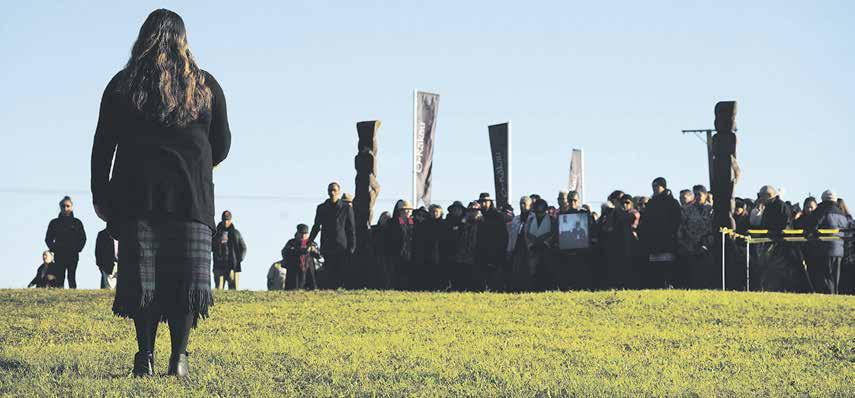
By Roy Pilott
The Ō-Rākau site of a bloody 1864 battle which helped define the New Zealand wars will be handed back to iwi – Waikato-Tainui, Ngāti Raukawa and Ngāti Maniapoto.
The Te Pire mō Ō-Rākau, Te Pae o Maumahara / Ō-Rākau Remembrance Bill passed its third reading in Parliament this week – just days before the commemoration of the attack on nearby Rangiaowhia.
The bill’s passing followed passionate speeches from all sides of
the house.
Māori Development Minister Tama Potaka said the 9.7ha battle site will be managed by a body representing the descendants of those who fought as well as their whānau, hapū, and iwi.
New Zealand First’s Hana-Rawhiti Maipi-Clarke noted “not often does this House come together — all six parties.”
She also referred to students including Leah Bell from Ōtorohanga who after a 2014 visit to Ō-Rākau joined with three others to petition
the government to commemorate the land wars and introduce New Zealand’s history curriculum in schools.
Labour’s Adrian Rurawhe told the House “this is not the end day, though. This is just the beginning of a new journey that starts with the passing of this legislation that enables the people who were most impacted, the descendants of those who were in that battle, to find a way forward and to commemorate what had happened there. Why? So that our future generations will know the truth
about our own history. Growing up in Aotearoa New Zealand, I did not learn that at school, and so I wanted to briefly acknowledge the day, acknowledge the significance of it.”
Labour colleague Shana Halbert said “today is one of those wonderous days for us in Parliament - for us as Māori, a Māori Affairs Committee, for all members who serve in this House - because we get to do something that’s right, to correct some of the challenges of our past, to apologise for the things that
Continued on page 9
A grant from the Clare Foundation will allow Braemar Charitable Trust to deliver free dental procedures and dental surgeries to six women’s refuges across the Waikato region.
Clare funds groups who can make positive change happen for women, oral health, youth well-being and the environment.
It will fund Braemar Charitable Trust $180,000 across the next three years to deliver dental help to
women’s refuges in the wider Waikato region.
Braemar Charitable Trust owns Braemar Hospital, one of the largest private hospitals in New Zealand.
The Trust’s range of free community surgeries are delivered by surgeons and anaesthetists who are credentialed to work at Braemar Hospital and want to donate their time. The Trust pays for other costs including nursing care, drugs and consumables. It also
works closely with dentists, oral surgeons and other oral health professionals and groups who give their time, free or at a reduced rate, to help those in need.
The Clare Foundation funding is designed to deliver dental assistance for women who have been the victims of domestic violence and are staying in refuges in Hamilton, Taupo, Tokoroa, Waitomo, Hauraki and Taumarunui.
Waitomo covers rural,
coastal and town areas in Waitomo and Waipā from Mōkau to Cambridge including Te Kūiti, Benneydale, Kāwhia, Te Awamutu.
Trust Manager Paula Baker says for those women accessing support in women’s refuges, dental work can be life-changing.
“We know how hard it can be for many to access dental care and some women have historical or urgent dental issues that require attention.”

Paula Baker
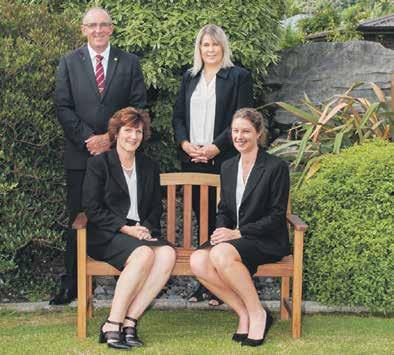





By Janine Krippner
Misinformation is not new. Sometimes confusion reigns and wrong information is innocently shared. Sometimes tabloids make clickbait headlines that are wildly misleading, so you visit their website, and they make money. Now we also have people on social media posting misinformation for likes in stressful and even dangerous situations. This situation is so urgent that I wrote about the topic online last week.
I am following the situation around Santorini, where there is real danger to people experiencing frequent earthquakes. This is a situation that is truly impacting communities and there is a risk that something worse may happen, like a larger, more damaging earthquake.
Now that we have AI and much more convincing fake videos to contend with, we must be even more cautious and sceptical, especially if we are viewing something on social media. So how can we tell?
Firstly, who is the source? Is it a trustworthy agency who checks facts? Is it an expert or trusted local - or someone who tends to post a lot of dramatic videos for likes with captions containing all caps and hyped-up language?
There seems to be a race to be the first to post about an eruption these days. The desperation to go viral might have something to do with it.
Does something seem off about the video? Is the colouring wrong? Does something about the physics, like water behaviour, seem a bit weird? Is the colouring saturated or a bit unrealistic? If there are people, is their behaviour odd? Are features blurred? AI generated images can get things wrong, like adding the wrong number of fingers. Are people responding as you would expect them

to during an eruption?
There is a term ‘uncanny valley’ that refers to feeling ‘off’ when looking at something that isn’t quite real. Go with your gut and check again.
Looking at the landscape is important. Santorini is a very recognisable island with steep slopes and the classic white buildings. Some people have shared a video of Whakāri with a gas plume.

EuroNews used reverse image search to identify our backyard volcano was standing in as a fake.
I’ve even seen an old computer-generated simulation of an Auckland volcanic field eruption shared with claims of It depicting past eruptions at other volcanoes in very different landscapes. That was made back when it was obviously not real… if you take the time to look.
What else is in the image or video? Is everything to scale? Make sure there isn’t any strange blurring between objects, or any areas that look too smooth or air brushed.
Is there any text? There might be repetition of words or bad spelling if there is.
Sometimes it just takes slowing down and taking a few seconds before sharing something online, but it is getting trickier. We can point out when something isn’t right in the comments so that others can see it too.
In hazardous situations we all have a role to play in making sure we are sharing good information.
We might be all the way over here in Aotearoa, but people being impacted by these events can see what’s posted online and this can cause very real distress.
By Tom Roa, Tikanga Advisor, Waikato University
I wonder how many of us applied for annual leave on the Friday, taking advantage of the Waitangi holiday to turn it into a long Waitangi Weekend.
I suggest that if we’re honest, that will have been how the vast majority of us regard Waitangi Day - enjoying the holiday, aware of the significance – and how can we not be with so much media – mainstream as well as social – attention to events at Waitangi and elsewhere? But I suggest the vast majority of us treat it essentially as another holiday.
The significance of Te Tiriti o Waitangi has been recognised with this holiday. And I know of no adult New Zealander who does not appreciate that significance in recognising the importance of Te Triti in our national consciousness.
For Māori Te Tiriti has long been a discussion point amongst us and other New Zealanders on marae and at Māori events.
I don’t envy the task of the Parliamentary Select Committee in their sifting through the thousands of submissions to them on the Principles of the Treaty of Waitangi Bill. I do suggest that this is merely a continuation of those conversations, unfortunately, in my opinion, a waste of parliamentary resources given that two of the coalition partners have indicated they will not support it through its second reading.

In our backyard here in the Waipā District more and wider conversations have been exploring the significance of the tragedy of Rangiaowhia where I and others assert that in the aftermath of the signing(s) of Te Tiriti o Waitangi, the potential of principled prosperity for the signatories of Te Tiriti was being realised.
Rangiaowhia was an agricultural hub which sent produce not only to major townships like Auckland, New Plymouth and Wellington nationally, but also internationally to Sydney, England, and even to the goldfields of America.
Indeed, the very first sacks of flour from the very first mill at Rangiaowhia were sent as a gift to Queen Victoria.
Pākehā tradespeople were welcomed by the Ngāti Apakura and Ngati Hinetū leadership in the later context of the second Māori King’s assertion that his friends came from all corners of the globe. They were the honest tradespeople, the shoemakers, the carpenters, the blacksmiths and the bakers of bread. Their contribution to the prosperity of Rangiaowhia was much celebrated by the hapū and iwi of the district as well as their visitors from other iwi who bore witness to the very important contribution of these people to the affluence enjoyed there by all. So much so that the newcomers took wives (and husbands!) from the local population and adopted their language and customs, partnering with Ngāti Apakura and Ngāti Hinetu to mutual benefit.
But then the empire-builders followed the norm of that time which was with the waging of war for building empire. Cooperation, collaboration with the people who were already in that space didn’t fit with that model.

*Finance o er available on New Nissan Navara models registered between 01/01/2025 and 31/03/2025. Approved applicants of Nissan Financial Services New Zealand only. Fixed interest rate of 1% p.a. only available on loan terms up to 24 months (3.9% p.a. applies for 25-36 months, 4.9% p.a. applies for 37-48 months and 5.9% for 49-60 month loan terms). No deposit required. Terms and conditions apply. This o er includes an establishment fee of $375, PPSR fee of $8.05, Dealer Origination Fee of $495 and $10 account keeping fee. All lease and some eet purchasers excluded. Nissan reserves the right to vary, extend or withdraw this o er. Not available in conjunction with any other o er.





By Mary Anne Gill
A 34-page memo from Delivery
Performance manager Sherryn Paterson in an open forum last week helped Waipā councillors decide a seven council regional organisation was the better option for their district, including Waitomo and Ōtorohanga.
Her memo was also the first opportunity for the public to appreciate the nuances involved in the water saga.
Waipā will be in the box seat of a regional model likely to be more attractive
to the government than one with Hamilton city and Waikato district councils.
After weeks of meetings behind closed doors, Waipā opted to join a council controlled organisation (CCO) to deliver water and wastewater services with Matamata-Piako, Taupō, Waitomo, Ōtorohanga, South Waikato and Hauraki district councils.
Thames Coromandel has not entered into a heads of agreement but is expected to join the other six soon.

Hamilton and Waikato, which had pitched a three-council partnership to Waipā the week before, will remain outside the regional model.
The Waipā decision must be formally approved at its meeting on February 26 but given the council released a media release within hours of its workshop last week, there is little doubt it will be rubber stamped.
Consultation will then take place with the community from March 21 and a water services delivery plan lodged with the government by September as part of the Local Government (Water Services) Bill which will replace Labour’s controversial Three Waters legislation by mid-year.
Smaller councils like Ōtorohanga and Waitomo would feel more comfortable with Waipā in the mix.

While there was no staff recommendation, the information presented made the response compelling.
Waipā will be the only high-growth tier one council in the preferred choice whereas it would have been one of three in the other organisation.
“Waipā would be a ‘foundation’ shareholding council, while with the sub regional CCO, there is no clarity on whether Waipā would become a foundation shareholder,” said Paterson.
Hamilton and Waikato’s short term focus on a two council model with the ability for other councils to join, was seen by Waipā councillors as a ‘big brother’ attitude.
Under the preferred model, Waipā would migrate its core water and wastewater businesses to the new CCO on day one –July 1, 2026 – and subject to employment processes, would include all operational staff. The News understands that would involve at least 40 per cent of council’s total staffing.
“As a tranche one council, Waipā would have the opportunity to influence and impact the establishment and transition arrangements with the other shareholding councils,” said Paterson.
“This model has a wider rural and provincial focus, which will likely provide a great operational model, workforce, civil contractor and relationship benefits across the shareholding councils.”
Financial modelling for the regional water option shows efficiencies of $10 million over eight years, starting July next year, for the preferred choice, with none factored into the Hamilton-Waikato option until year five.


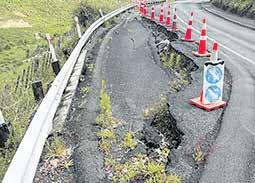
Work to install a timber retaining wall to repair Kent Street in Te Kūiti could start as soon as April.
“While it may seem we have taken quite some time before repair works could start, further investigation and a thorough assessment were required before a detailed design could be undertaken,” Waitomo District Council’s General Manager Infrastructure Services, Shyamal Ram said.
The street has slumped significantly over the past few years, and an “easy quick fix” was not a suitable option. Ram said a detailed design for a timber retaining wall is underway.
“Due to the geological conditions of the land under the road and the impact of continuous weather events, Kent Street will require significant works to reinstate the road.”
A detailed geotechnical assessment had been undertaken to help determine the best remedial options.
The project will be funded through the NZ Transport Agency (NZTA) Resilience Fund, and that will reduce the financial impact on ratepayers.
Construction is expected to take place between April and August following a tender process.
The council said during that period, residents could expect disruptions and possibly road closures.









By Jon Rawlinson
King Country hunters may hand over efforts to find a Wellington man missing in the region for almost a month.
After Travis Langford’s car was found burnt out on a Tolley Road farm in Ngaroma, January 18, hunters began searching for him in dense bush at Pureora Forest. However, police have now confirmed the 24-year-old is thought to have moved on further into South Waikato.
“In recent weeks, there have been sightings of a man in the Waipapa and Mangakino areas who fits the description of Travis,” a police statemen said.
“Police would like to hear from anyone who has seen or heard from Travis, or has any more information about the man seen in the South Waikato area wearing long pants, no shoes and carrying a backpack.”
Police have not ruled out the possibility that Langford is in the forest, but more recent sightings of suggest this now may not be the case.
As reported previously in The News Sophie Juno discovered the body of a woman, Judy Donovan, missing in the forest for almost a year, while searching for Langford earlier this month.

Search and Rescue staff, police and the Eagle helicopter began searching the Ngaroma / Pureora Forest area in late January. Some personal items were discovered. Private searches have also been carried out by family and friends.
Police are asking people to check any outbuildings, sheds, barns and abandoned buildings on their properties for Travis or any sign of disturbance.
“If anyone has any information that could help our enquiries, please update us online now or call 105”.
Meghan Hawkes looks back on what was making headlines in King Country in 1922.
Harley Davidsons were the motorcycle of choice for the Te Kūiti police proving far cheaper than the horse when time was considered.
Their popularity in America was attested to by 49 police chiefs who all spoke very highly of the motorcycle for their work, finding that the Harley Davidson was the most economical, most durable and efficient.
Not as durable though was the Te Kūiti police sergeant’s residence which was noted with disgust to be falling to pieces and without a lick of paint for years.
Ōtorohanga residents were being pestered by an individual who opened conversations by asking in an earnest tone for ‘painkiller.’ He got strong tea in one house, and some quack medicine in another. At one house, though, he quite settled in, and the constable had to be called to move him on. He was described as a drug fiend.
As if this wasn’t enough - potatoes, cabbages, peas, and other vegetables appeared to be the favourite food of a certain cow which was allowed to roam Ōtorohanga streets night after night. People were getting tired of this animal and suggested that the police take action.
The proposal that the Waitomo Caves needed to be more widely advertised was made to the Minister of Tourist Resorts. If the caves were lighted by electricity and full publicity given to the attractions of the district, Waitomo would rank second to Rotorua in popularity. There were great possibilities for making it one of the most popular health and tourist resorts in the Dominion, but the hostel there was in a state of disrepair. Accommodation was only sufficient to allow visitors to stay for one night. The manager and staff did everything possible for guests but they were hampered by the reluctance of the Government to spend money on the buildings.
The hostel was beautifully situated and the grounds could be made very attractive. It would not cost a lot to construct lawn tennis courts and croquet and bowling greens at the hostel. There were many people in Auckland who would make the caves a health resort. During the hot weather in the city many would stay at for recuperative purposes if the facilities were available.
A Mōkau farmer installed in his milking shed a device for recording the weight of each individual cow’s milk. The simple part consisted of a face with an index hand similar to that of a clock. Just as the milking of a cow was finished the hand recorded on the dial the weight of the milk given.
The owner swore that the very first day he set up the machine each cow on backing out of the bail immediately turned round and scanned the face of the dial with the greatest interest.
Later on he noticed all the cows in the yard having an argument among themselves, presumably as to which had given the greatest quantity of milk.
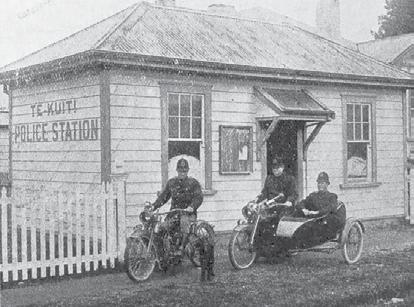


By Roy Pilott
Antifluoride campaigner and local body politician
Kane Titchener is celebrating New Zealand First’s call for a referendum to review the move to put decisions over fluoride into the Ministry of Health’s court.
Winston Peters accepted Fluoride Free NZ’s petition - that the House of Representatives stop water fluoridation – last week and on the same day New Zealand First introduced a member’s bill that would repeal the Health (Fluoridation of Drinking Water) Amendment Act 2021 and mandate councils to hold binding referenda.
The Act is the legislation which authorised the Director General of Health to mandate the fluoridation of local water supplies – and saw outgoing director general Ashley Bloomfield make orders to a host of councils, including Waipā, which was told to add fluoride to the Cambridge supply.
The district council is abiding by the demand, but Titchener, deputy chair of the Te Awamutu-Kihikihi Community Board has consistently called for councillors to resist.
Titchener hosted a meeting
in Cambridge last week where US lawyer Michael Connett, who scored a significant Federal Court case win for anti-fluoride campaigners, spoke to a full Cambridge Town Hall.
In the US a judge, Edward Chen, ruled plaintiffs had proven fluoridation of water at 0.7 mg a litre - the level prescribed in the US and used in New Zealand – “poses an unreasonable risk of reduced IQ in children”.
“Everyone who attended that presentation is now up to date with the latest science,” Titchener said. “It just can’t be denied any longer that fluoride is a neurotoxin and should not be added to the water supply. We are calling for a moratorium and a public inquiry.”
Winston Peters said of the party’s bill the only people who would oppose it are “those that oppose democracy” – but there is no indication National MPs would support it.
National made the first move a decade ago to remove fluoridation decisions from local government to district health boards with then associate Health minister Peter Dunne saying water fluoridation was a healthrelated issue. It was shifted
instead to the DirectorGeneral of Health in 2021.
Titchener said invites to last week’s meeting went to all district councillors.
He said one, Philip Coles attended, as did Cambridge Community Board members Jo Davies-Colley and Andrew Myers. Coles left early.
The US judge ruled that “fluoridation of water at 0.7 mg per litre poses an unreasonable risk of reduced IQ in children.” Connett received standing ovations
at each of the packed eight public events throughout his New Zealand tour. He spoke to councillors from Whangārei, Kaipara, Far North, Tauranga, Western Bay of Plenty, Rotorua, and Palmerston North. Rotorua District Council have also called for a public inquiry after listening to Michael Connett’s workshop presentation. Whangarei District Council are taking legal action in order to not start fluoridation due to
the health concerns from neurotoxicity.
Meanwhile, Winston Peters stepped in to support Whangārei district councillors who are resisting the fluoride mandate this week. “It is chilling that we have got to a point in New Zealand where elected politicians are being threatened with imprisonment just for doing their jobs, standing up for democracy and asking for a vote,” Peters said.

By Mary Anne Gill
Concert pianist Michael Houstoun and blues singersongwriter Hammond Gamble have been confirmed for next month’s Cambridge Autumn Festival.
The pair will perform on consecutive nights at The Woolshed in Te Awamutu Lifecare Village. This will be their debut at the festival, which started 15 years ago.
The festival has a reputation for fostering young talent. This year’s group to watch is La Voce o Rotorua, a recently formed male trio likened to Sol3 Mio, singing opera, musical theatre and waiata.
The biggest public involvement is on March 29 with the Main Street Carnival and Art Market in Victoria Street and on the Square while the Repair Revolution has arrived at the festival with workshops and demonstrations on how to mend school uniforms and broken ceramics.
For those thinking of running away to join the circus, there is even a workshop on learning circus skills.
The festival starts and finishes in the Town Hall - on March 28 with the Art Exhibition and Sale and April 6 with Youth Orchestra Waikato taking inspiration from classical works that have become integral to popular culture, film and television.













Katrina Christison Tidy Gardens
It was a delightful sight to wake up to light drizzle this morning, as we all know we certainly need it.
Stepping outside, I could already see how the garden looks fresher and happier.
With planting season not too far away, now is the perfect time to start thinking about rejuvenating your garden — or even creating a new one.
The best place to begin is by imagining the feeling you want your garden to give you when you look at it or step out into it.
Do you have a view from your window that you want to enhance? Would you like a native garden, a romantic garden, or maybe something more minimalist?
The possibilities are endless! Once you’ve decided on the overall vibe or theme for your garden, you can start thinking about the practical elements that will bring it all together.
Do you need a new path, a seat to retreat to in the Summer heat, or perhaps it’s time to replace old pavers with something fresh?
Sometimes, a simple cleaning and
a fresh coat of paint on fences, sheds, or screens can do wonders, giving your outdoor space a revitalized look just in time for Autumn.
Perhaps there are some plants you’d like to move around, or a particular plant that has been thriving in this summer’s heat?
Add them to your plant wish list to add more in Autumn, or consider what other plants grow well in similar conditions.
For me my Mutabilis Rose aka The Butterfly Rose has had no extra water from me.
No deadheading or spraying and she has flowered from Spring and will keep doing so right though to winter.
It is a graceful rose with masses of slender pointed buds that open to a soft yellow then change to coppery tones of pink then changing to crimson tones.
The single flowers float and dance above the foliage like butterflies hence the name.
So I have added a few more on the other side of the lawn which will create a beautiful flow, which will guide my eye around my garden and link both gardens together creating a sense of unity and movement.

One of the leading lights behind the restoration of Kihikihi’s Alpha Hotel has come out in favour of a waste to energy plant in Te Awamutu.
Bill Harris is Hamilton based but is a member of two trusts operating around Te Awamutu which pay rates in Waipā.
In his submission to the Environmental Protection Agency board of inquiry due to be heard in June, he says he supports all parts of Global Contracting Solutions resource consent application to build and run a Waste to Energy Incinerator in Racecourse Road.
“I have spent time with the present landowner Chris Venn and his family who I have found to be very genuine people,” he wrote.
“They are learned town and country citizens who spent considerable time, study and resources looking into this proposal before agreeing to even sell their land to Global Contracting Solutions.
“Likewise, I have thought long and hard about alternatives to landfill options for our waste and believe waste to energy is the best most present option we have. Zero waste is a good goal but
at present there remains waste which as a country we are not able to recycle.”
He said he was not an expert in all the science of the application but had watched and read about incinerators overseas.
“I have visited countries like Singapore where incinerators are used to exchange waste to energy and there are positive outcomes.
I am not an air emission expert but I’m happy that if this consent did not meet all our national standards the applicants and this application would not have progressed even this far.”
Harris, who spent parts of his youth in Kihikihi recalled his grandfather worked for the council when it ran landfill rubbish dumps on Paterangi Road and in Kihikihi.

“As a youngster I spent many hours in the care of my grandfather at these two dumpsites. I saw not just the size of these council run dumps but also what went into these dumps. Old tyres, stripped and unstripped car bodies, which in some case still contained fuel and oil. These old vehicles which were crushed, I believe will still be leaching into our whenua and waterways. In those days I recall we did manage to recycle bottles and some bikes.”
He suggested the proposed plant would provide an alternative to landfills, “which I strongly support… and anything that can in the first instance be recycled will be”. He said he hoped many of the 60 jobs being created would be filled by Apakura and Hinetu iwi.
“Those employees may not presently live within the district, but in the building and operation of this plant I hope more of our people who were driven from rohe will be able to return to Te Awamutu and the district.”

By Jesse Wood
Longtime volunteer Zelda Nortje has taken over the reins of Lovings Arms, which has supported thousands of parents and caregivers across the Waikato.
Since 2014, the Te Awamutu-based charity helped more than 6000 babies and their families with clothing, bedding, nappies, toiletries and items such as cots, car seats and prams.
The organisation covers a circumference of an hour away from Te Awamutu but has also serviced other areas including Taumarunui when volunteers are passing through.
Loving Arms has provided close to $6 million worth of clothing and equipment.
Last year alone they helped 1437 families.
After 10 years at the helm, founder Sharni Budd stepped away last June due to health reasons.
“It actually started a few years earlier than 2014. It was just my wife saying, ‘I can help you’.
“There was a 17-year-old mum about to have a baby and had nothing,” co-
founder and board member Jamie Budd said.
“Sharni put out her feelers on social media for some items and having a large family, we also provided some. More items kept arriving and then another mum popped up.
“There were quite a few families that we helped before Sharni birthed Loving Arms officially.
Then we started capturing information as we became a charity.”
Zelda was by Sharni’s side for nearly seven years and was the right fit for the operations manager role.
“I met Sharni on the side of a soccer field in Te Awamutu. I saw one of the first newspaper articles,” Zelda said.
“I had a blanket to gift her. I always feel that I want to do whatever God puts in front of me. Loving Arms was run out of a container at Zion Church at that stage.
“I started with volunteering, some washing at home and sorting clothing. It progressed and we became good friends.
“It was really nice seeing Sharni’s journey through it.
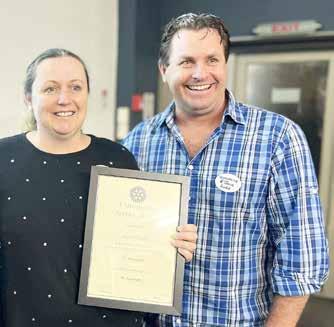
All the decisions she made, all the new things that have come along. She’s taken one thing after the other in her stride. I’ve been there for the journey but not necessarily carrying the load.”
Zelda said it’s heartbreaking because there’s so much need in the community, but it’s amazing they’re able to help.
“There has been a lot of work from all the volunteers, lots of behind-the-scenes prayer and plenty of support from the community.
“It means a lot that we get to do that.”
Jamie said it’s been huge to have Zelda step up with the same heart as Sharni.
“Loving Arms is Sharni’s baby. She birthed it, loved it, and put everything of herself into it.
“To know that Zelda has been here for eight years, and Sharni could step away and the heart of it can be carried on is tremendous,” he said.
“Having a community like that who picks up the ball and carries it is amazing. It’s not one person; it’s a
community that are doing this together.”
There have been countless volunteers since the project started.
They enjoy the experience because it’s not a one size fits all, they are encouraged to use their strengths.
At present, there are about 26 volunteers involved including a delivery driver, sorters, washers, sewers and packers.
“You couldn’t do this without the community and our lovely volunteers. We feel like a family, everyone does as much as they can to help wherever it’s needed on that day,” Zelda said.
“I feel very support by our Loving Arms board members and the Budd family.”
Zelda said if families need help, ask for help and Loving Arms can help, they will.
“It’s the starfish story. For this family that we’re packing a box for now, that’s going to make a difference.
“It’d trying not to look at
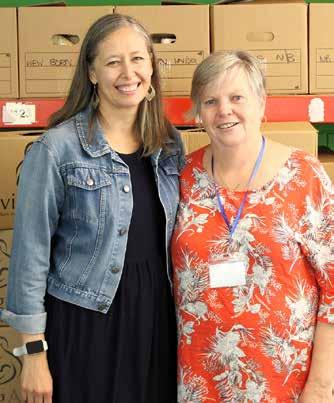
the ones that we might miss because we can’t get there fast enough.
“But for every family that gets something, every story




we hear back and every box that goes out, it’s awesome to know they are being helped and there’s a bit of a burden taken off of them.”
Continued from page 3 the Crown has done wrong, and most of all to make it right.”
In April last last October more than 1000 people gathered at the site near Kihikihi to honour the 160th anniversary of O-Rākau, the story of which was told in the film Ka Whawhai Tonu – Struggle Without End, the story of the Battle of Ōrākau released last year. There a deed of agreement providing for the transfer of the pa site was signed.
The government history site recounts at least 160 of Ō-Rākau pa’s 300 occupants were killed and British casualties from more than 1400 solders was 17 over three days from March 31 to April 2.
It was reported that women were bayoneted as they lay wounded, and
disgust was expressed at the “general obscene and profane behaviour” of troops under Lieutenant-General Duncan Cameron.
The same site notes the events of Ōrākau were gradually mythologised, and when a monument was erected on the site in 1914, 50 years after the siege, it was Māori heroism rather than British ferocity that was remembered.
The year after the battle, the Crown confiscated thousands of hectares of Waikato land, including the site at Ōrākau.
Maor Development Minister Tama Potaka said the legislation sought to return the whenua.
Willie Jackson, Labour, also celebrated – he acknowledged the mahi of Tom Roa, a regular columnist in The News - but questioned the
compensation – the pūtea.
“$1.7 million for the transfer of the Ōrākau site at no cost to iwi, $75,000 to fund the establishment of managing entity for the Ōrākau site, $306,000 to fund historical research. It’s chump change, really. Both governments can take responsibility for that—I’m not just talking about National here… When are we going to look at proper compensation for kaupapa like this… when are we going to have a re-look at this situation where our people have to go through so much? Yes, they get the apology, and then they’re just about funding the whole thing themselves.
Hōhā - hōhā.”
The bill has been passed in time for the transfer of the land to be completed before the 161st anniversary of the battle.


Summary of pricing plans
Residential Low Fixed Charge is only available to customers in their principal place of residence (home) and is usually best for those who use less than 8,000 kWh per annum.
Residential Standard is only available to customers in their principal place of residence (home) and is usually best for those who use more than 8,000 kWh per annum.
General is where the end use we have recorded is not ‘holiday home’, ‘accommodation’ or ‘dairy cattle milking shed’ and includes pumps, sheds, etc.
Temporary Accommodation is where the end use we have recorded is ‘holiday home’ or ‘accommodation’.
Dairy is where the end use we have recorded is ‘dairy cattle milking shed’.
RTLFCHU427HighUncontrolled0.15510.41820.02670.6000-0.10890.49110.19480.2030-0.03720.16580.12680.1350-0.02420.11080.05730.0655-0.01090.0546
RTLFCLU219LowUncontrolled0.12150.45760.02090.6000-0.11920.48080.23610.2532-0.04900.20420.16810.1852-0.03490.15030.09860.1157-0.02050.0952
RTSTDHC2,094HighControlled0.38771.04550.06681.5000-0.27231.22770.10950.1095-0.01960.08990.09400.0940-0.01680.07720.02450.0245-0.00440.0201
RTSTDLC1,016LowControlled0.52631.98300.09072.6000-0.51642.08360.10950.1095-0.01960.08990.09400.0940-0.01680.07720.02450.0245-0.00440.0201
RTSTDHU356HighUncontrolled0.38771.04550.06681.5000-0.27231.22770.16200.1620-0.02900.13300.09400.0940-0.01680.07720.02450.0245-0.00440.0201 RTSTDLU279LowUncontrolled0.52631.98300.09072.6000-0.51642.08360.16200.1620-0.02900.13300.09400.0940-0.01680.07720.02450.0245-0.00440.0201 RNLFCHC26HighControlled0.15510.41820.02670.6000-0.10890.4911
GT15HU1,114HighUncontrolled0.39061.69210.06732.1500-0.44071.70930.17800.1780-0.03190.14610.10250.1025-0.01840.08410.02450.0245-0.00440.0201
GT15LU1,252LowUncontrolled0.44932.37330.07742.9000-0.61812.28190.17800.1780-0.03190.14610.10250.1025-0.01840.08410.02450.0245-0.00440.0201
GT30HC63HighControlled1.21433.07640.20934.5000-0.80123.69880.12300.1230-0.02200.10100.09000.0900-0.01610.07390.02450.0245-0.00440.0201
GT30LC19LowControlled1.32133.95100.22775.5000-1.02894.47110.12300.1230-0.02200.10100.09000.0900-0.01610.07390.02450.0245-0.00440.0201
GT30HU167HighUncontrolled1.21433.07640.20934.5000-0.80123.69880.14200.1420-0.02540.11660.09000.0900-0.01610.07390.02450.0245-0.00440.0201
GT30LU62LowUncontrolled1.32133.95100.22775.5000-1.02894.47110.14200.1420-0.02540.11660.09000.0900-0.01610.07390.02450.0245-0.00440.0201
GT70H190Highn/a 2.63686.90880.454410.0000-1.79928.20080.11300.1130-0.02020.09280.08200.0820-0.01470.06730.02450.0245-0.00440.0201
GT70L154Lown/a 3.10138.86420.534512.5000-2.308410.19160.11300.1130-0.02020.09280.08200.0820-0.01470.06730.02450.0245-0.00440.0201
GT150H40Highn/a 5.527515.51990.952622.0000-4.041817.95820.09600.0960-0.01720.07880.07500.0750-0.01340.06160.02450.0245-0.00440.0201 GT150L37Lown/a 6.151019.28901.060026.5000-5.023321.47670.09600.0960-0.01720.07880.07500.0750-0.01340.06160.02450.0245-0.00440.0201
DT15HCn/aHighControlled0.39061.69210.06732.1500-0.44071.70930.11200.1120-0.02010.09190.10250.1025-0.01840.08410.02450.0245-0.00440.0201
DT15LCn/aLowControlled0.44932.37330.07742.9000-0.61812.28190.11200.1120-0.02010.09190.10250.1025-0.01840.08410.02450.0245-0.00440.0201
DT15HUn/aHighUncontrolled0.39061.69210.06732.1500-0.44071.70930.17800.1780-0.03190.14610.10250.1025-0.01840.08410.02450.0245-0.00440.0201
DT15LUn/aLowUncontrolled0.44932.37330.07742.9000-0.61812.28190.17800.1780-0.03190.14610.10250.1025-0.01840.08410.02450.0245-0.00440.0201
DT30HCn/aHighControlled1.21433.07640.20934.5000-0.80123.69880.10950.1095-0.01960.08990.09000.0900-0.01610.07390.02450.0245-0.00440.0201
DT30LCn/aLowControlled1.32133.95100.22775.5000-1.02894.47110.10950.1095-0.01960.08990.09000.0900-0.01610.07390.02450.0245-0.00440.0201
DT30HUn/aHighUncontrolled1.21433.07640.20934.5000-0.80123.69880.12600.1260-0.02260.10340.09000.0900-0.01610.07390.02450.0245-0.00440.0201
DT30LUn/aLowUncontrolled1.32133.95100.22775.5000-1.02894.47110.12600.1260-0.02260.10340.09000.0900-0.01610.07390.02450.0245-0.00440.0201
DT70Hn/aHighn/a 2.63686.90880.454410.0000-1.79928.20080.09800.0980-0.01760.08040.08200.0820-0.01470.06730.02450.0245-0.00440.0201
DT70Ln/aLown/a 3.10138.86420.534512.5000-2.308410.19160.09800.0980-0.01760.08040.08200.0820-0.01470.06730.02450.0245-0.00440.0201
DT150Hn/aHighn/a 5.527515.01990.952621.5000-3.911517.58850.08200.0820-0.01470.06730.07500.0750-0.01340.06160.02450.0245-0.00440.0201
DT150Ln/aLown/a 6.151019.03901.060026.2500-4.958221.29180.08200.0820-0.01470.06730.07500.0750-0.01340.06160.02450.0245-0.00440.0201
DN30HUn/aHighUncontrolled 1.21433.07640.20934.5000-0.80123.6988
DN150Ln/aLown/a 6.151019.03901.060026.2500-4.958221.2918 0.06660.0666-0.0119
TT15HC187HighControlled0.39062.54210.06733.0000-0.66202.33800.11200.1120-0.02010.09190.10250.1025-0.01840.08410.02450.0245-0.00440.0201 TT15LC107LowControlled0.44933.47330.07744.0000-0.90453.09550.11200.1120-0.02010.09190.10250.1025-0.01840.08410.02450.0245-0.00440.0201 TT15HU89HighUncontrolled0.39062.54210.06733.0000-0.66202.33800.17800.1780-0.03190.14610.10250.1025-0.01840.08410.02450.0245-0.00440.0201 TT15LU195LowUncontrolled0.44933.47330.07744.0000-0.90453.09550.17800.1780-0.03190.14610.10250.1025-0.01840.08410.02450.0245-0.00440.0201 TT30HCn/aHighControlled1.21434.57640.20936.0000-1.19184.80820.12300.1230-0.02200.10100.09000.0900-0.01610.07390.02450.0245-0.00440.0201
TT30HUn/aHighUncontrolled1.21434.57640.20936.0000-1.19184.80820.14200.1420-0.02540.11660.09000.0900-0.01610.07390.02450.0245-0.00440.0201
TT30LUn/aLowUncontrolled1.32135.95100.22777.5000-1.54985.95020.14200.1420-0.02540.11660.09000.0900-0.01610.07390.02450.0245-0.00440.0201
TT70Hn/aHighn/a 2.63689.20880.454412.3000-2.39829.90180.10900.1090-0.01950.08950.08200.0820-0.01470.06730.02450.0245-0.00440.0201
TT70Ln/aLown/a 3.101311.66420.534515.3000-3.037612.26240.10900.1090-0.01950.08950.08200.0820-0.01470.06730.02450.0245-0.00440.0201
TT150Hn/aHighn/a 5.527519.51990.952626.0000-5.083420.91660.09200.0920-0.01650.07550.07500.0750-0.01340.06160.02450.0245-0.00440.0201
Prices
Delivery prices are the prices we bill your electricity retailer and are made up of different components: Distribution, Transmission and Pass-through prices. Embedded Generation prices are for energy injected into the distribution network and are $0.000 per kWh. TLC Discount prices are used to calculate the TLC Discount for Waitomo Energy Services Customer Trust Customers. Pass-through prices are related to other costs and regulatory incentives and the prices are $/kWh:
Transmission prices include TLC’s charges from Transpower. TLC’s recovery of these costs is included in daily and variable prices ($/kWh):
All prices exclude GST. Our other prices (e.g. those for capacity and dedicated asset customers) are available on our website. The pricing schedules, methodology and TLC Discount rules will be available on our website before 1 April 2025.
Variable pricing times
Peak 7am – 9.30am | 5.30pm – 8pm Shoulder 9.30am – 5.30pm | 8pm – 11pm Off Peak 11pm – 7am

Utility Disputes: If you have a complaint, please call 0800 367 546 or email us at info@thelines.co.nz to access our free complaints process. If we cannot resolve your complaint, you can contact Utilities Disputes on 0800 22 33 40 or go to www.udl.co.nz. Utilities Disputes is a free and independent service for resolving complaints about utilities providers.
RTLFCHC0.10000.6576-0.00760.7500-0.15280.59720.14870.1674-0.02950.13790.12720.1459-0.02550.12040.05740.0574-0.00930.0481
RTLFCLC0.10000.6576-0.00760.7500-0.15280.59720.21030.2290-0.04380.18520.18880.2075-0.03980.16770.11900.1190-0.02360.0954
RTSTDHC0.50631.4523-0.05861.9000-0.33751.56250.11500.1150-0.02110.09390.09350.0935-0.01710.07640.00500.0050-0.00090.0041
RTSTDLC0.50632.8023-0.05863.2500-0.65122.59880.11500.1150-0.02110.09390.09350.0935-0.01710.07640.00500.0050-0.00090.0041 RTSTDHU0.50631.4523-0.05861.9000-0.33751.56250.14000.1400-0.02560.11440.09350.0935-0.01710.07640.00500.0050-0.00090.0041 RTSTDLU0.50632.8023-0.05863.2500-0.65122.59880.14000.1400-0.02560.11440.09350.0935-0.01710.07640.00500.0050-0.00090.0041
RNLFCHC0.10000.6576-0.00760.7500-0.15280.5972
RNLFCHU0.10000.6576-0.00760.7500-0.15280.5972 0.12500.1399-0.02440.1155
RNLFCLU0.10000.6576-0.00760.7500-0.15280.5972 0.18660.2015-0.03870.1628
RNSTDHC0.50631.4523-0.05861.9000-0.33751.5625 0.07830.0783-0.01430.0640
RNSTDLC0.50632.8023-0.05863.2500-0.65122.5988 0.07830.0783-0.01430.0640
RNSTDLU0.50632.8023-0.05863.2500-0.65122.5988 0.08750.0875-0.01600.0715
GT15HC0.50632.4523-0.05862.9000-0.56992.33010.11500.1150-0.02110.09390.10100.1010-0.01850.08250.00500.0050-0.00090.0041 GT15LC0.50633.3523-0.05863.8000-0.77903.02100.11500.1150-0.02110.09390.10100.1010-0.01850.08250.00500.0050-0.00090.0041
GT15HU0.50632.4523-0.05862.9000-0.56992.33010.14000.1400 -0.02560.11440.10100.1010-0.01850.08250.00500.0050-0.00090.0041
GT15LU0.50633.3523-0.05863.8000-0.77903.02100.14000.1400-0.02560.11440.10100.1010-0.01850.08250.00500.0050-0.00090.0041
GT30HC1.01255.1046-0.11716.0000-1.18624.81380.11500.1150-0.02110.09390.08750.0875-0.01600.07150.00500.0050-0.00090.0041
GT30LC1.01256.6046-0.11717.5000-1.53485.96520.11500.1150-0.02110.09390.08750.0875-0.01600.07150.00500.0050-0.00090.0041
GT30HU1.01255.1046-0.11716.0000-1.18624.81380.14000.1400-0.02560.11440.08750.0875-0.01600.07150.00500.0050-0.00090.0041
GT30LU1.01256.6046-0.11717.5000-1.53485.96520.14000.1400-0.02560.11440.08750.0875-0.01600.07150.00500.0050-0.00090.0041 GT70H2.362512.9108-0.273315.0000-3.000311.99970.14000.1400-0.02560.11440.07750.0775-0.01420.06330.00500.0050-0.00090.0041
GT70L2.362515.4108-0.273317.5000-3.581313.91870.14000.1400-0.02560.11440.07750.0775-0.01420.06330.00500.0050-0.00090.0041
GT150H5.062525.5231-0.585630.0000-5.931324.06870.14000.1400-0.02560.11440.06500.0650-0.01190.05310.00500.0050-0.00090.0041
GT150L5.062535.5231-0.585640.0000-8.255131.74490.14000.1400-0.02560.11440.06500.0650-0.01190.05310.00500.0050-0.00090.0041
GN15HC0.50632.4523-0.05862.9000-0.56992.3301
0.08100.0810-0.01480.0662
GN15LC0.50633.3523-0.05863.8000-0.77903.0210 0.08100.0810-0.01480.0662
GN15HU0.50632.4523-0.05862.9000-0.56992.3301
GN15LU0.50633.3523-0.05863.8000-0.77903.0210
GN30HC1.01255.1046-0.11716.0000-1.18624.8138
GN30HU1.01255.1046-0.11716.0000-1.18624.8138
GN70H2.362512.9108-0.273315.0000-3.000311.9997
DT15HC
No longer applicable. The Lines Company has transformed the way it charges distribution. We have consolidated a number of these to simplify our charging structure. These charges have been incorporated into General TOU. No longer applicable. As above. These charges have been incorporated into General Anytime.
TT15HC0.50633.1523-0.05863.6000-0.73262.86740.11500.1150-0.02110.09390.10100.1010-0.01850.08250.00500.0050-0.00090.0041 TT15LC0.50634.3523-0.05864.8000-1.01143.78860.11500.1150-0.02110.09390.10100.1010-0.01850.08250.00500.0050-0.00090.0041
TT15LU0.50634.3523-0.0586 4.8000-1.01143.78860.14000.1400-0.02560.11440.10100.1010-0.01850.08250.00500.0050-0.00090.0041
No longer applicable. As above. These charges have been incorporated into General TOU.

What’s behind the pricing category simplification?
There are two types of charges - fixed daily and consumption prices (per kWh) which mostly vary according to the time of day (TOU).
We have revised prices and simplified our pricing structure by amalgamating customer groups with similar load profiles; reducing the number of price category codes. We are moving Dairy and larger Temporary Accommodation connections into their respective General code. You do not need to do anything. We have let your electricity retailer know.
0.09020.0902-0.01650.0737
0.09020.0902-0.01650.0737
0.07610.0761-0.01390.0622
0.08530.0853-0.01560.0697
0.08160.0816-0.01490.0667
If you are unsure what your current or new price category code is, please contact us or visit: www. thelinescompany. co.nz/pricing/

Questions or concerns?
Please call us on 0800 367 546.
This advert details Waitomo Energy Services Customer Trust (WESCT) pricing.
For NON-WESCT pricing please visit our website: thelinescompany. co.nz.



By Jon Rawlinson
Benjamin Franklin said that there’s nothing certain in life except death and taxes – and as a King Country councillor and funeral director, Bruce Williams, has had a hand in both.
For most of his life, Bruce assisted generations in matters of life and death, as well as rates, on the Waitomo District Council and as a funeral director at Te Kūiti-based VJ Williams & Sons. In December, he received a certificate from the Funeral Directors Association in recognition of 65 years of faithful service.
“I never thought about getting any recognition,” he says. “I don’t like being in the limelight, I just enjoyed my work and helping people. When they approached us, they were at a really low ebb. We cared about helping them through such a tough time of their lives.”
When not taking care of people through his business, Bruce was taking care of business on behalf of the people.
“I enjoyed my time on council. I was a deputy mayor under Les Munro for 12 years and did five terms on the council in total. It was a great way to help people.”
Established by Bruce’s father in
1952, VJ Williams & Sons is now owned by Phil New and remains a well-established family firm. Asked if his father would approve of its new owners, Bruce doesn’t hesitate.
“Yes, definitely. We taught Phil to be a funeral director. He was manager for about 10 years before he bought the business. He knew the methods and the processes my father (Vic Williams) and I had used and Phil has the same attitude towards helping people.”
Phil would also be a deserving community champion – in addition to running VJ Williams, he volunteered with the NZ Fire Service for nearly 40 years, including as chief and station officer. Similarly, his wife, Janene, and other staff members are busy with community causes.
Even after he sold the business, Bruce returned for a further curtain call.
“I had retired but I went back to work because Phil was sick. I just went in to help out a bit and I still enjoyed it.”
Both Bruce and his father trained as builders before turning their hand to the funeral business and there’s at least one more case of ‘like father, like son’ running in the Williams family.
“My son, Garth, is a funeral


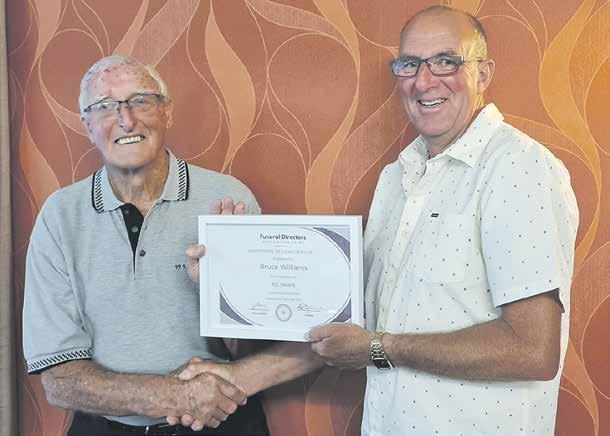
director at Te Awamutu Funeral Services,” Bruce says. “He was also a builder, and then he worked for me for a couple of years. When the Te Awamutu business came up for sale, he became a funeral director in
his own right.”
Building skills came in handy for all three generations of the Williams family when constructing monuments and caskets. Now aged 86, Bruce has retired (again) and moved to the Coromandel. However, he regularly returns to the King Country and South Waikato to visit family and many others who have become like family to him over the years.
















Just spray – and fly away
Jack Care’s ‘weaponised’ drone is engaged in regular seek and destroy missions - and the primary enemy is gorse growing in hard-to-reach areas on the farm. Jon Rawlinson reports on Care’s plans of action on Page 5 today.

*


•
•
•
•
•

• Quality, professional advice to farmers and businesses
• Expert taxation and business structure planning
• Family trust management
• Friendly, personalised service Contact us for a FREE NO OBLIGATION INTERVIEW to discuss your financial requirements www.baileyingham.co.nz
18 Maniapoto St, Ōtorohanga 07 873 7325
41 Bank St, Te Awamutu 07 870 1888 29 Hakiaha St, Taumarunui 07 895 7312 info@baileyingham.co.nz
• Employment law
• Estate planning
• ETS & forestry
• Rural law
• Trust law
• Wills & estate administration
• Wind farming
Hugh Jackson is back in the running for the FMG Young Farmer of the Year title after securing victory in the Waikato Bay of Plenty Regional Final.
The 27-year-old based in Hamilton claimed the top spot on Saturday after a day of intense competition at Waerenga School, east of Te Kauwhata, tackling a series of practical and theoretical challenges.
The win qualifies him for his second Grand Final appearance – he finished third overall in 2023.
The FMG Young Farmer of the Year competition celebrates top talent in New Zealand’s food and fibre sector. Now in its 57th year, it boasts an overall winner’s prize pool of more than $90,000.
“I’m stoked to get another shot at Grand Final. Getting back there is never guaranteed, and I’m looking forward to giving it everything,” says Jackson.
“The Waikato Bay of Plenty is a tough region to compete in, so I knew I had to put in plenty of prep to give myself a decent shot. I was hoping for the win, but nothing was guaranteed with the strong competition I had.”
“This is probably my last crack at the big dance, so it’s now or never to give it everything. I’m definitely not heading to the Grand Final to come second!”
Participants entered one of three categories based on age, ranging from the AgriKidsNZ competition for primary school pupils, the Junior Young Farmer of the Year for High School
Students, and the Young Farmer of the Year category, where eight contestants battled it out for the top spot.
They included Laura Davis, who grew up on a farm in Piopio, and now works with Beef and Lamb New Zealand as an Extension Manager and is based in Hamilton.
Jackson edged his way to victory by clocking up the most points on the day, defeating fellow Hamilton Young Farmers member Stephen Brunskill. Will Evans from Piarere Young Farmers secured the final spot on the podium.
“There were a few modules where I learned heaps, changing a bearing on a tyre was something I’d never done before and struggled with, but now I know how,” Jackson said.
“The New Holland module was also a challenge for me, getting the settings set up correctly on the tractor was something new to me and I needed some guidance to complete the module.”
The AgriKidsNZ competition was won by Heidi Morris, Angus Gregory, Harrison Gregory from Elstow-Waihou School emerged as the region’s victors. Jacob Bolt, Isaac Wilson, John Woodward, from Otewa School and Homeschooled, placed second, just ahead of Brearna Bolt, Sam Bluett, Jack Woodward, also from Otewa School and Homeschooled.
Ben Ede and Stephen Ede
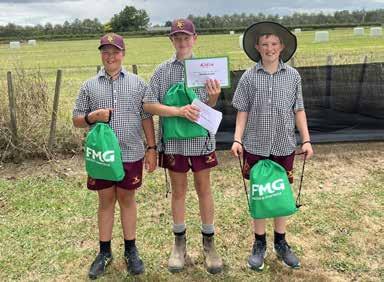
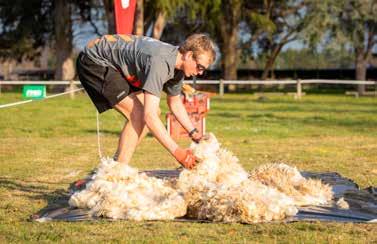
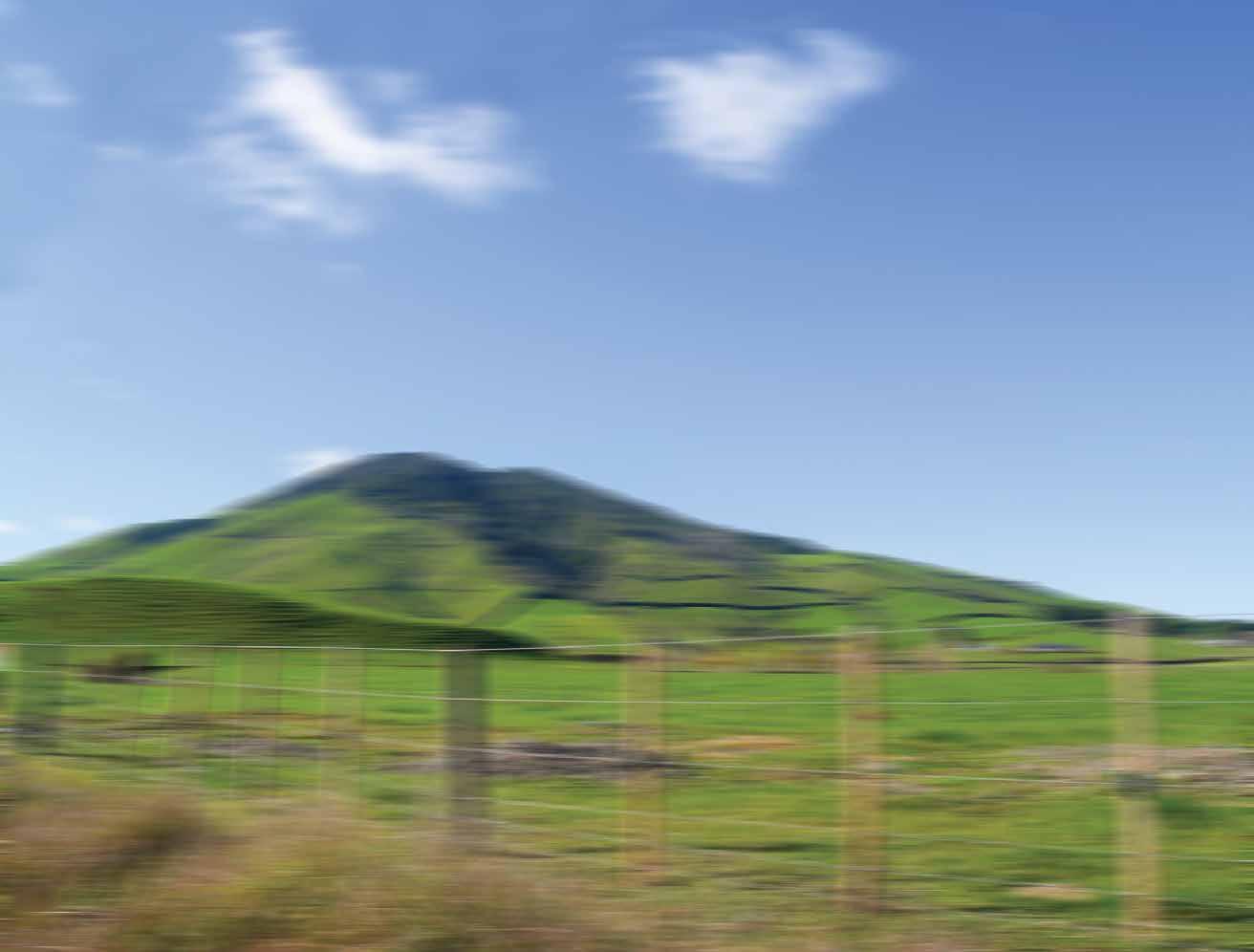
in May, before they







It would be reasonable to assume that any chap named nicknamed ‘Digger’ would be more inclined to value silver spades rather than golden shears. However, this shearing veteran explains to Jon Rawlinson, in competition or in the shed it pays to dig deep.
In addition to his day job, grinding it out in many a shearing shed, Richard ‘Digger’ Balme from Ōtorohanga is gearing up for another crack at competitive shearing’s highest honour.
At 60, he has stocked his trophy cabinet with world championships, world records and more, but one accolade has been elusive.
It could be a case of 10th time’s the charm for Balme at the Golden Shears starting next week but, as he concedes, youth could trump experience.
“I’ve had numerous wins with some of my biggest overseas – I won the Bath and West Golden Shears and the Corwen Shears [Wales], but the New Zealand Golden Shears is the Wimbledon of shearing.
“I think I’m getting too old to be right at the top level, but I’ll give it my best shot.
“I’ve made nine finals with my best coming second to David Fagan. Just making the finals is always big.”
Considering Sir David Fagan has 16 Golden Shears Open titles (a record to rival the All Blacks’), second is pretty impressive.
Southland’s Leon Samuels is the defending champ, and an eight-time winner, Rowland Smith (Hawke’s Bay), will be back after missing the 2024 event through injury. Balme also rates another.
“David Buick (Pongaroa) would have to be right up there. I think Rowley’s not quite where he wants to be at the moment, but he’s more than capable of making the finals again too.”
Beyond the Golden Shears, the NZ Shearing Champs in Te Kūiti (March 27-29) beckons.
However, Balme is also one of 10 top shearers invited to compete at the Rural Games in Feilding (March 7-9) where speed shearing is the name of the game.
Like a cricket test match, the golden Shears is the true test shearing, you want to shear as clean and as fast as you can, Balme says.
“…Speed shearing is more like T20 cricket, it’s real entertainment for the spectators and it’s over in a short time – you might only get to shear one sheep in the heat and then, if you’re lucky enough to make the final, you might get another.
“I made [a Rural Games] final once. If I can make it into the top four again this time, it’d be pretty good.”
Balme says another King Country competitor to watch at the Rural Games is Jack Fagan – he recently nipped across the ditch to claim the Oberon Quickshear title in a blistering 19.78 seconds.
“Jack’s cutting his own path, more in the speed shear, and he’s doing well in competitions.”
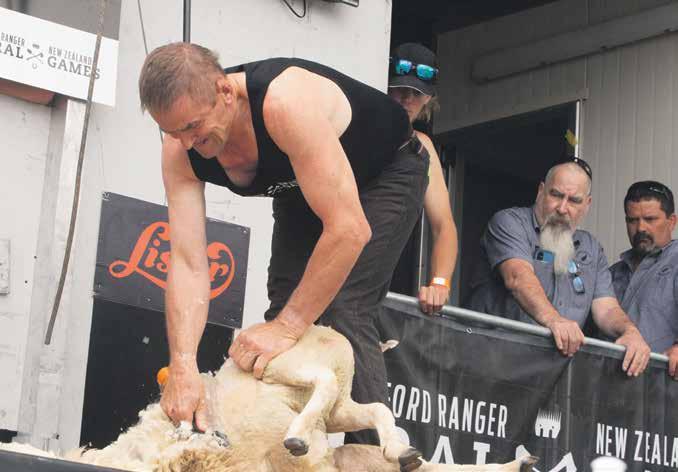

When it comes to the hard graft of hands-on rural competition, there’s no question which region wears the crown.
“There’s actually not as many shearers down here now, but there was a lot of gangs back in the ‘80s and ‘90s with a number of good shearers in all of them,” Ōtorohanga shearer, Digger Balme, says.
“It was common to have 10-15 shearers from Te Kūiti and Piopio at competitions… the likes of Paul Grainger, Mike Barnett, John Ruki, Alan Macdonald, Colin King, Edsel Forde and John and David Fagan, of course – they were all shearing here in the King Country back then.”
Sir David Fagan is clearly shearing’s undisputed sovereign with a record 16-time Golden Shears Open victories to his credit. However, the list of today’s best ‘upper-cutters’ from the region is hardly spartan; it includes the progeny of some of the shearers Balme mentions, such as Jack Fagan, Mark Grainger and James Ruki, as well as a top gun female shearer, Sacha Bond, to name just a few.
Balme’s sons have had parts to play in the sport. A former Golden Shears Novice winner, Josh Balme is now focused on rugby – a former King Country Ram who now plays for Mooloos – and his brother, Kyle, is never too far from the action. And yet, this does not mean Digger is content to hang up his handpiece.
Retirement?
“I don’t know if I’ll be able to because Kyle, he’s our autistic boy, gets so much enjoyment from the shows. He’s a regular at them and everyone is just so good to him. Jack [Fagan] is one of his favourites; he gets really excited when he sees him. Jack’s been working for me so he spends a lot of time with Kyle.”
Balme is helping to teach one of King Country’s best prospects, ‘Fagan the younger’, after learning from the very best, Fagan ‘senior’. However, he first picked up the clippers in north Waikato.
I’m originally from Tahuna, just north of Morrinsville. We shifted to Tuakau when I was a teenager and I started shearing when I was about 17,” he recalls. “When I hit the open grade, I


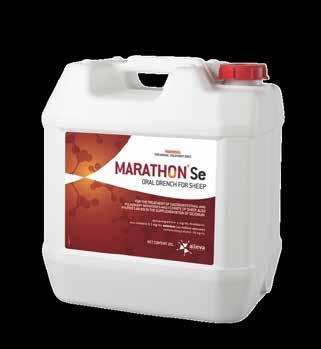
By Stu Kneebone , Waipa-King Country councillor
Waikato Regional Council recently confirmed its proposed Annual Plan budget.
Thanks to a lot of good work by our chief executive and his staff, careful consideration by councillors and following a series of workshops with councillors last year, we collectively managed to reduce the rates increase proposed in the Long Term Plan from 8.6 percent down to a proposed 5.9 per cent.
The proposals associated with this change will be consulted on in April.
One key issue that I do want to highlight is the changes we are making to the way public transport is managed and funded.
Regional councils are responsible for the planning, management and provision of public transport in the region.
Traditionally this has often meant that district and city councils have collected the rates funding for public transport in their area or district and handed this over to the regional Council to operate the service.
This has invariably meant it was a complicated system with a range of different approaches in terms of how the rates portion to fund public transport was collected.
This also made it challenging to plan transport across the region, and didn’t contribute to providing an ideal network of services throughout the Waikato.
In an effort to improve things, the regional council resolved via the recent Long Term Plan consultation process to take over the rating to fund public transport across the region.
As a reminder, there are essentially three components that make up the public transport funding system.
One is the fare component paid by the actual bus users. The remaining portion (which is effectively the main component) is 51 per cent funded by the government’s National Land Transport Fund (road users) and the remaining 49 per cent is funded by councils (ratepayers).
The rates component has traditionally been
collected differently (for example, general rates, targeted rates or per-property charges) depending on the approach of the particular council.

With the regional council taking over the rating across the region for public transport, a decision has to be made as to how we do this. Last year the council spent some time engaging with other councils across the region to understand their views.
Following this consultation, we are proposing to rate for public transport across the Waikato via a per-property charge applied to all ratepayers across whole region.
There is also an option for a capital value charge to apply for Hamilton City ratepayers.
This per-property charge will be different, depending on which part of the region you are in, given this affects your likelihood and ability to use public transport.
This does mean that areas with no bus services do pay something, recognising that public transport does take cars off the road, and thus does provide some benefits for everyone.
In addition to this, New Zealand Transport Agency has directed that councils are expectedto increase the private share component (bus fares) of public transport funding.
In response to this, the council is proposing to increase public transport fares by 11.4 per cent from July 1 to reflect inflationary increases in public transport operating costs and to meet the government targets.
Fares will then increase by 10 per cent a year in the four subsequent years.
Formal consultation on these options will be undertaken in March or April of this year, providing an opportunity for public feedback to council.
We will be looking to adopt the 2025/26 annual plan budget in May.
By Mary Anne Gill
Waipā District Council is poised to change its District Plan to accommodate the burgeoning kiwifruit and horticulture industry.
The proposed changes include reducing road and internal boundary setbacks for protective structures over fruit from 15 metres to six metres, allowing transparent cloth as a colour option for the structures, and replacing shelterbelt shading rules with new height and road setback measurements.
The changes were prompted by the influx of kiwifruit growers into the district over the past three years, who established unconsented kiwifruit shelter structures.
Ōhaupō life styler Nick Jennings settled with the council last year after mediation when he filed papers with the Environment Court over the council’s decision to let his neighbour in Parallel Road establish a kiwifruit operation.
He argued that the expansion of the kiwifruit orchard around three sides of his rural property blocked his views and ruined his rural outlook. Similar issues have arisen elsewhere in the district on land previously used for farming.
Policy planner Alice Morris presented the
proposed changes at an elected members’ workshop last week.
Work on the plan change began last year and resulted in feedback from more than 70 individuals and groups. Planners reviewed shelterbelt planting rules, rural zone boundary setbacks, building coverage rules, and colour standards for shade cloth structures. They considered the impact of shelterbelts on neighbouring properties, road safety, and road maintenance.
Morris emphasised the importance of enabling the “full use” of rural land for primary production while balancing the need to maintain outlooks, views, appearances, and cultural values.
Deputy mayor Liz Stolwyk said she hoped the suggested changes would be well communicated as after the original publicity two years ago, it had disappeared from people’s radars.
The issue has been tracked during that time by Good Local Media.
Mayor Susan O’Regan said the work had been tricky because it needed to balance all the competing values. Some of the setbacks had been “outrageous” so it was pleasing to see some compromise among submitters. “But (Waipā) is nevertheless a rural food producing zone.”
The plan will now be finalised and sent to iwi authorities before its adoption mid-year by the Strategic Planning and Policy committee.
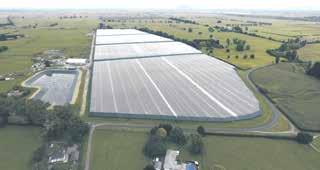
Submitters argued the protective structures destroyed views and dominated the rural landscape
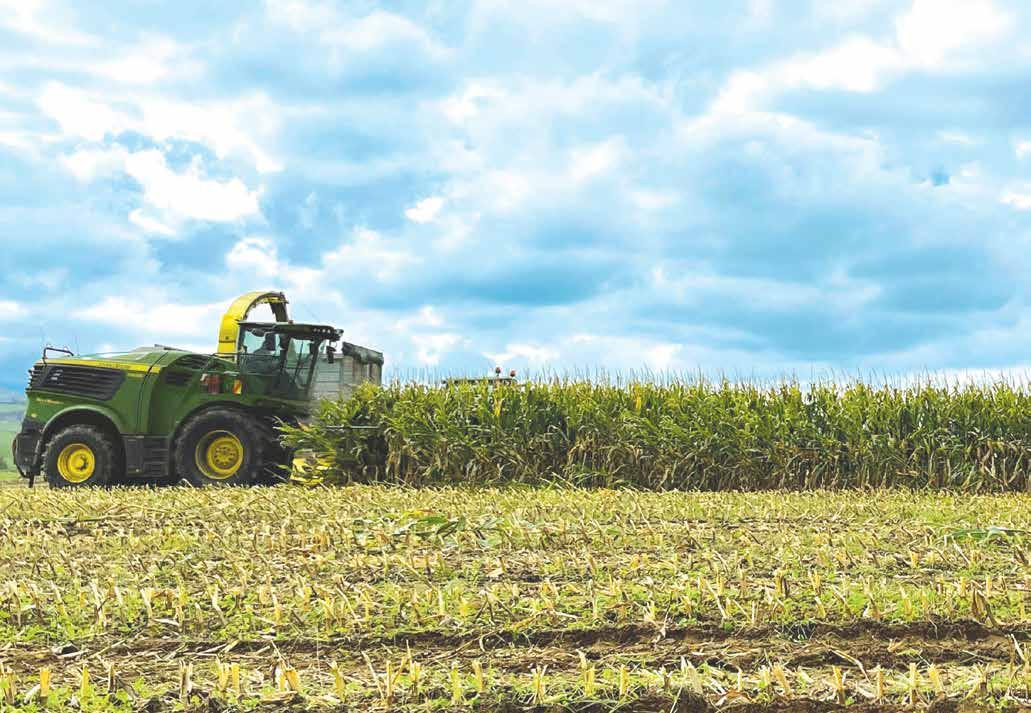

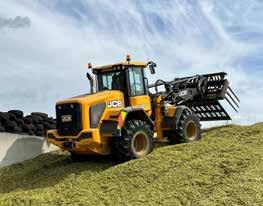
By Jon Rawlinson
Slogging up the back paddock of a King Country hill farm with a 16 litre knapsack loaded with herbicide is a tough row to hoe.
Even more likely to give one the ‘pricker’, and add injury to insult, is if a small patch of troublesome irksome gorse is the target. So, who cares? Jake Care does.
Since adding a new service to his family’s business – Ōtorohanga-based AgVice – a few years ago, Access Drone Spraying’s Jake Care has been taking care of a business that really is… taking off.
“A lot of farmers would haul up a 20 kilogram hose as well other gear in the middle of a hot summer. Another option is to get a helicopter in, but that’s not worthwhile for a small patch,” he explains.
“I’m not spraying a whole farm like a helicopter, or a plane would, or gorse on the flats because that can be done with a tractor.
“But, if there’s gorse on the top of a bluff, in weird little spots or on really steep hillsides, my drone [a DJI T16] is ideal.”
Just as the first fighter planes were designed for reconnaissance, Care’s drones were focused on aerial mapping before being weaponised in the war against weeds a few years ago.
Since then, he has been flying numerous sorties, nipping gorse and other pest plants in the bud.
“We don’t just spray gorse, though, any weeds – thistles, ragwort, blackberry – we kill all sorts.”

Established by his mother, Dr Debbie Care, the family business, AgVice, provides advisory services for farmers.
Spraying weeds is just a small aspect of the business, but it is gaining in popularity.
“It’s not a full time thing, just in summer, and I still do farm maps, area measurements and look at plant health, things like that.
“After doing a lot of that, we thought we’d give spraying a crack.”
As such commercial applications of drones require a licence, and should not be tackled by ‘civilians’, Care has been busy with jobs across the Waikato, King Country and beyond.
With farms and lifestyle blocks of all shapes and sizes his crosshairs, he has also been recruited to tackle public parks on occasion.
Small and nimble, drones can deliver with deadly accuracy when rooting out wellentrenched targets while ensuring other plants aren’t hit by ‘friendly fire.’
“A big benefit of drones is they can just spray the target you’re after so plants right next to it will survive.
“I can just spray the gorse whereas a helicopter might have no choice but to hit the natives around it,” Care confirms.
“I have a three-metre swath, so anything within that area is going to be hit, but three metres is the size of your average gorse plant anyway.”
Despite the (relatively) diminutive nature of his aircraft, Care has big plans for his small business enabling him to increase effectiveness with less flight time.

“There are much bigger drones coming out – that’s the goal, to get a new, bigger one,” he adds.
“Mine’s a 16 litre. It depends on exactly what I’m spraying, but I can cover just under
a quarter of a hectare of gorse, just as an example.
With the newer one’s I’m looking at – the T30 or T40 – I could spray more than double the area.”









































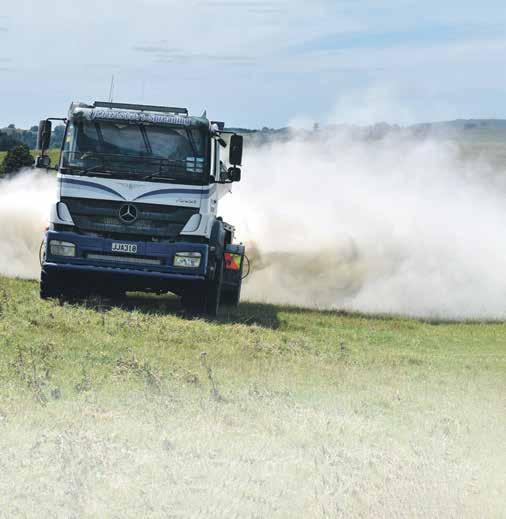








Selling a horse privately might seem simple, but it comes with serious legal obligations. While the Consumer Guarantees Act 1993 (CGA) and Fair Trading Act 1986 (FTA) don’t apply to private sales, sellers must still comply with contract law principles to ensure a fair transaction.
Misrepresentation: The Truth Matters
Honesty is non-negotiable. Misleading claims about the horse’s age, health, training, or temperament can lead to disputes, claims for damages, or even cancellation of the sale. If a buyer asks a question, you are legally bound to answer truthfully.
Selling “As-Is”: Cover Your Bases
Selling a horse “as-is” might limit liability for postsale issues, but it’s not a get-out-of-jail-free card. Misrepresentation during the sales process still carries consequences. Protect yourself by using a clear, written contract that explicitly outlines the “as-is” condition and terms of sale.
Buyer Beware: Good Faith Still Counts While buyers are expected to do their own due diligence, “buyer beware” doesn’t let sellers off the hook. Acting in good faith and providing honest, accurate information remains a legal duty.
Why Honesty is Your Best Policy
Being upfront about your horse’s condition isn’t just about avoiding disputes—it builds trust within the equestrian community. For professional guidance on drafting agreements or navigating the sale process, contact Edmonds Judd. We’re here to help make your sale smooth, transparent, and hassle-free.

Fiona Jack

By Chris Gardner
Farmers have only weeks to wait to learn the extent of a Waikato Regional Council water quality plan change on their operations.
As they wait for the final version of Plan Change One to fall out of the Environment Court process, following appeals from key primary industry players, council chair Pamela Storey and Federated Farmers Waikato president Keith Holmes are recommending the industry be prepared for change.
The Environment Court is expected to release its decision on Plan Change One before the end of March after the regional council was challenged by key primary industry players.
Plan Change One proposes a widesweeping set of rules for agricultural land use to improve freshwater quality in the Waikato and Waipā River catchments. It will apply to around 10,000 properties and a land area of 1.1 million hectares within the two catchments.
“Waikato Regional Council has heard from stakeholders that a roadmap is needed for how farmers and growers will be supported to implement Plan Change One,” said Storey.
make sense on-farm,” said Holmes.
Examples of issues Federated Farmers appealed include which waterbodies stock need to be excluded from, setback distances, how critical source areas are identified and managed, and how often fertiliser spreaders need to be calibrated.
“Along with other parties, we’ve been on a long journey of council hearings, mediations and, more recently, Environment Court hearings,” he said.
“This has been an incredibly drawnout, expensive and uncertain process for everyone involved, including Federated Farmers.”
The aim was to reduce the cost to farmers and bureaucracy.
“Time and money are better spent on environmental mitigations than expensive consenting processes,” he said.
“We’re crossing our fingers that the end might now be in sight and that the final wording of Plan Change One works for the environment and is also sensible, practical and affordable for our productive sector.”
‘The outcome will matter for all farmers around New Zealand as what happens here could set a precedent that will impact other regions.’
– Keith Holmes
“It’s impossible to predict what the Environment Court might decide, but farmers and growers in the Waikato and Waipā river catchments have been aware that new rules are coming.”
Storey is married to a fourth generation Waikato dairy farmer Ian. She is also a former member of the Dairy Women’s Network Trust Board.
“While it’s not easy to do when we don’t yet know what Plan Change One will look like, our stakeholders are fully engaged with our Primary Industry Engagement team,” she said.
“As part of this, staff are also looking at systems to support landowners to meet their Plan Change One obligation. Farmers, growers, and regional sector representatives are actively involved to help us ensure these systems meet their needs.
“They’ve been doing a great job already to actively implement good farming practices which are at the heart of farm environment plans.”
Farm environment plans help manage environmental risks and improve profitability and long-term viability.
“They look at the farm and farm system, identify work which have already been completed and plan any environmental work which needs to be undertaken in the future to protect land and water quality.
“They’re designed to be a living document – that means they can be updated as the business or other factors change.”
Holmes said while a lot was still uncertain farmers could start thinking about their record keeping assisting with preparing farm plans and demonstrating all the work, they’re already doing to lighten their environmental footprint.
“The rule making process began in 2012 and Federated Farmers has been involved at every stage, appealing to the Environment Court many proposed policies and rules on the basis they didn’t
unnecessary costs and compliance on dairy farmers through resource consents and reporting requirements,” Burger said.
“DairyNZ’s evidence provided aims to reduce the unnecessary cost on farmers whilst still delivering on the outcomes sought.
“DairyNZ recognises that there are around 2000 dairy farms impacted by Plan Change One and although the decision is not yet made, we are working with dairy companies and Waikato Regional Council to support farmers through the process.”
Once a decision is made, DairyNZ will communicate it to farmers, and support farmers with education, awareness, and technical science support for those impacted.
The Environment Court is working through some technical issues that Holmes hoped would be resolved in the next month or so.
“Federated Farmers’ efforts to propose pragmatic solutions for unworkable parts of the plan have made a significant difference,” Holmes said. “A lot is still uncertain.”
Original proposals included that farmers might not be allowed to cultivate within five metres of a water body, and there were significant limitations on when and how much nitrogen fertiliser could be applied.
“There’s a lot at stake, not just for the viability of local farms and the Waikato economy. The outcome will matter for all farmers around New Zealand as what happens here could set a precedent that will impact other regions.
Other councils are watching on to see the outcome of this, so what happens here could have flow-on effects to other farmers around the country.”
The Environment Court ruling is not the final word on the subject.
The repeal of the Resource Management Act before the next election will have implications for these rules.
“It is still unclear exactly how a new Resource Management Act may affect the Plan Change One rules,” Holmes said.
“Federated Farmers is highly engaged in the process to replace the Resource Management Act, and we will continue to update farmers on implications for local rules as more information comes to light.”
DairyNZ was another organisation to appeal against the plan change.
General Manager of farm solutions and policy David Burger said DairyNZ had invested significant resource into the plan change for more than a decade.
The organisation wishes to achieve workable evidence-based solutions for farmers while delivering on the outcomes sought through the vision and strategy for the Waikato Waipa catchment (Te Ture Whaimana).
“DairyNZ has concerns with the decisions version which places

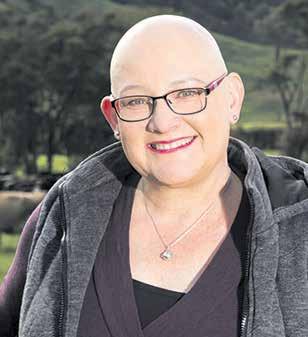
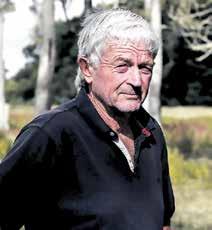
By Michael Catley, Veterinarian, King Country Vets
When we talk about drenching and being ‘wormwise’, we are talking about roundworms of the intestine affecting productivity - liver fluke, lungworm and tapeworm are kept as another topic.
Most species of worms are specific to the species of animal - sheep worms affect sheep (and goats), cattle worms affect cattle. The main problem is the affects they have on the true stomach (abomasum) and the small intestines.
The exception is some Trichostrongylus species that can be found in both cattle and sheep and significantly affect productivity.
The lifecycle of roundworms is not particularly complex. Adult worms live in the animal; worm eggs are deposited on pasture in poo; eggs develop into larvae in poo and migrate to pasture, where they develop to an L3 infective stage.
L3 infective larvae are ingested by livestock and develop into adults inside the animal. The female adult worm then mates inside the animal and produces eggs in about 21 days.
Development from an egg to infective L3 larvae can take from one to 10 weeks depending on environmental conditions; 20-25 degrees Celsius with moisture is required. Variability from these conditions will slow development or cause destruction of eggs/L1/L2 larvae.
L3 infective larvae are the exception and can survive for long periods on pasture. In cool environments, this can be up to a year or longer. In dry environments, this can be

as little as 2-3 months (surviving on their own reserves). Therefore, we sometimes steer away from the 28-day drenching intervals, with delayed development and life cycle in the larvae (but followed up with FEC monitoring). Different grazing patterns also affect the infection cycle, with lax grazing reducing the intake of infective larvae from pasture. Typically, it takes 21 days from when a sheep ingests a worm larvae to when worm eggs appear in dung samples (the prepatent period).
Seasonal patterns of worm burdens generally follow a consistent pattern, with an early peak in spring and a later larger peak in autumn.
Wintering numbers, stocking rates and feed levels at calving/lambing can affect the trends in this curve, with higher counts when nutrition is suboptimal (associated with a pre-partum rise in egg counts) and reaching peak lactation.
Most contamination contribution comes from young stock, particularly those less than 12 months (that season’s lambs or dairy beef mainly).
Understandably, the peak occurs in autumn due to the number of young stock under the age of 12 months, the seasonal conditions, preventative drenching programmes and cross-grazing policies.
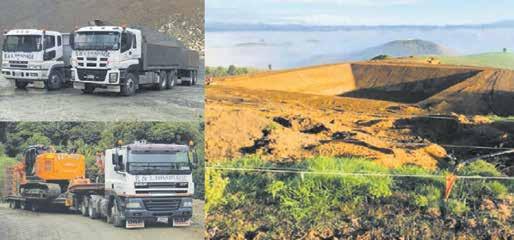





By Richard Steele
At heart, most of us landowners, set out to be good guardians of the land, and as the old and well-worn cliche goes, we set out to leave the land in better shape than it was in, when we started out our farming journey on it.
I’d say most of us succeed. Speaking for ourselves, conservation of the land rates as highly as making a profit from farming the land, and as we have a lot of country that is really too steep, and or too unstable to farm sustainably, maintaining that innate conservation ethic serves up its own share of troubles.
With the advantage of 100 years of hindsight, I believe in New Zealand, we have broken in, or developed, five per cent too much land, but in our class of country, that figure, could easily be higher. As much as 75 per cent too much.
We have hills with bluffs on them, that we can’t fence out for stock safety.
We have hills that erode at a far greater rate than nearby bush covered national park, a fair bit of our easier land is slowly slumping, with massive deep seated earth movements, that have been going on continuously since the land came out of the sea six million years ago, just before we came here and took up a mortgage.
So we fence off the creeks to keep the stock out where we can, we let the steepest hills revert to Manuka, which has been good for honey production, we have planted thousands of poplar and willow

trees to stabilise hills, and to arrest stream bed erosion, and we have fenced off old wetlands, innocently developed by unknowing previous owners, to let those wetlands do their thing by, cleaning up the water, and by increasing the bio diversity.
All good stuff, so what’s the problem?
Bloody blackberry, that’s what. The very birds we have set out to improve the lives of, have become conspirators against us by spreading something that nothing other than goats eat, and goats and conservation don’t work together either.
There is blackberry now in every area we have ever retired, and what to do with it is the question that’s on everybody’s lips.
There is no natural predator, we can’t blanket spray, without taking out everything we have planted, or has thrived in the reversion process, and the spot spraying we are doing is too little and not yet enough.
An introduced weevil or pathogen could do it, if it killed the blackberry, without taking out all the related plants.
Well beyond my pay grade to understand.
Lastly, this thought.
If God were good, why do his people’s, need lightning rods on top of steeples?






By Chris Gardner
Ian Brennan is proud to call himself a “tree pervert”.
Brennan has spent 18 years planting continuous cover native forestry on his hill country farm on Maungakawa Road, Te Miro near Cambridge after he witnessed the impact of soil erosion first hand.
“A big lump of earth came tumbling down past me,” he told fellow farmers at a field day held earlier this month.
“I thought, have we bought a lemon?”
Brennan swapped a 22-year career in software development for farming in December 2005.
“I just wanted my working life to be something I enjoyed,” he said.
Since then, Brennan has planted about 90,000 native trees in about 38 hectares on the 85 hectares farm he owns with his wife Equine Energetics owner Trisha Wren.
His first thought, after seeing soil erosion in action, was to begin planting parts of the farm out in natives.
He turned to kauri, kahikatea, rimu and totara. But where should he stop?
“I have just said anything that’s too steep to drive on can go back to forestry,” he said. “I will just farm what’s left.”
Farm, as in use what’s left for grazing a couple of hundred cattle.
“I went and bought some budget plants. Half of them died including kauri,” he said.
There’s been plenty of trial and error, with Brennan constantly reviewing what species to plant where.
“I replaced the kauri with totara… if I was to start again I would just plant totara.”
“If you just want to plant bush, a nursery crop is a good idea.”
It’s a solitary job. His days consist of either planting new trees or pruning the forest.
“I listen to podcasts all day, or I get into the groove.”
He enjoys The Great Simplification exploring “the systems science underpinning the human predicament” with Nate Hagens, 1980s music and Taylor Swift.
Of the 38 hectares of mostly steep gullies planted on the farm, 33 have been planted since 2016.
“We hit our stride with planting at a time when Waikato Regional Council, Waikato River Authority and Trees That Count all had funding available but there was a dearth of landowners looking to plant permanent forests - especially native forest,” Brennan said.
“When One Billion Trees was announced, we were already geared up to take advantage of that as well.”
He’s benefited from thousands of dollars of grants.
“We are planting entire gullies for catchment protection.”
The farm has six streams flowing into the Waikato catchment and one into the Piako catchment.
“Our point of difference is that we are planting all the main native timber species and managing them silviculturally to create a high-quality timber resource for future generations.”
The majority species is totara, with splashes of rimu, kauri, kahikatea, puriri, tanekaha, matai, rewarewa and taraire. In recent years Brennan has used manuka and
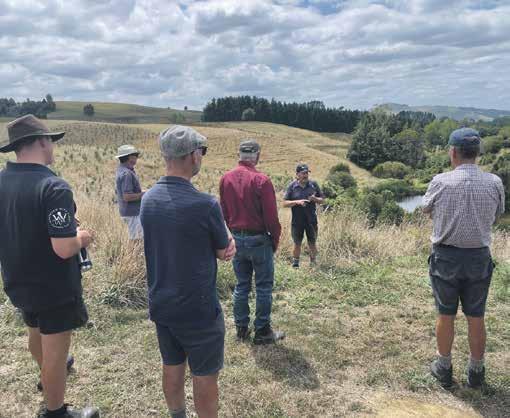
kanuka almost exclusively as nurse species to shade and protect the main crop.
“In the early years we used a wide variety of colonisers as nurse crop including tarata, kohuhu, karamu, lacebark, five finger, ribbonwood and wineberry.
“We found all of these species are too vigorous and quickly overtop the totara, stunting the tree and damaging the growing tips, making them sprout multiple leaders.
“This requires more silvicultural intervention, specifically form pruning to remove duplicate leaders in order to produce a single, straight log.”
Brennan has planted totara with the intention of creating a timber resource for future generations without a nurse crop as he has found that the nurse crop requires a lot of maintenance after five or six years.
“I find totara planted on its own, just like

Maize Silage
Forage Harvesters
Cartage & Stacking
Tractor/fruck + Trailer
lnoculant & Cover
Weighing & DM Testing available
�
Hay & Grass Silage
Conventional Hay Bales
Large Square/Round Bales
Mowing (Single & Triples)
Loader Wagon
Forage Harvesters
Cartage & Stacking
+ Bulk Truck Cartage & Hiab Truck Available




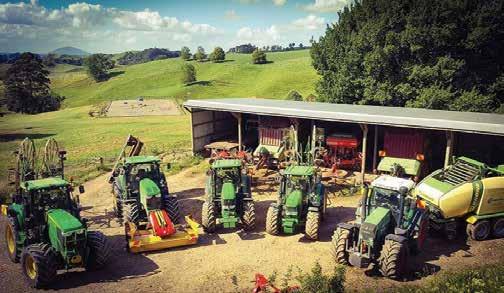

any other forestry species, is the best option. This is likely to be the case also with kauri and rewarewa.
“Puriri and tanekaha definitely benefit from being planted among an established nurse crop.
“The jury is still out on the other species with regard to using a nurse.
“If you simply want to plant a block of bush, then nurse crops are a potentially cost-effective way to get early canopy closure and thereby foreshorten the period during which you will need to walk through the planting and spray woody weeds like blackberry and inkweed.”
“New Zealanders have got this idea that every native tree is sacred, but the forest is the eco-system.
“As far as I know, we are the first people in New Zealand that has a covenant that allows harvest of a per centage of the trees.”
But Brennan’s goal is to grow a crop that can be sustainably harvested.
“Nobody has all the answers,” he said. “There are no right answers to any of this. We are still in the experimental stage on a lot of things.”
Brennan relies on the hunter community to keep the fallow deer population down forest damage to a minimum.
“My wife is a vegetarian, and I am a de facto vegetarian, and I have never been a hunter,” he said.
Brennan is playing the long game.
He realises that he will never benefit from the harvest, neither will whoever he sells his farm to when the times comes.
“I don’t have to do it all,” he said.
“The forest will continue to grow for hundreds of years.
“The next person can do some, if they want to be a tree pervert like me.”
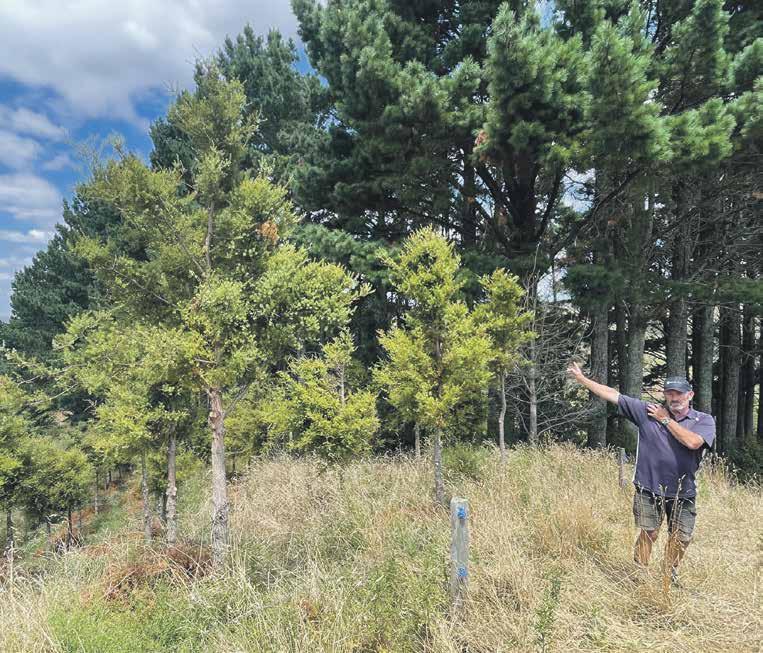





• Kuhn combi
- Round baler/wrappers
• Case big square baler & wrapper
• Forage harvester with trucks or tractors/trailers
• Full mowing services
• Bale stacking
• Hay/silage for sale
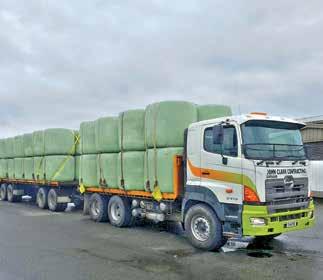
• Maize silage contracts available • Full service available -
Disc, power, harrow, roller drill • Striptill maize planting
1 pass with Base/Starter fert • 8 row planter • Fodder beet planter • Direct drills
Fert/seed/slugbait/clover bins • Side dressing/Spraying for maize ground
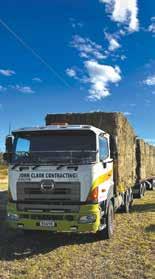
Diggers

Any farmer that harvests or buys crops risks inviting one of the world’s most invasive pest plants onto their property – to their detriment.
Velvetleaf seeds can lay dormant in the ground for half a century.
The weed, which is spread by machinery or via contaminated maize, is found on 105 properties in nine regions of the North Island: 61 in the Waikato, 20 in Auckland, 15 in Manawatū-Whanganui, three in Hawke’s Bay, two in Wellington, and one each in Northland, Taranaki, Gisborne and Bay of Plenty.
North Island Velvetleaf Coordinator Sally Linton, who is employed on behalf of the North Island regional councils, Auckland Council and the Foundation for Arable Research, says the issue is that farmers buy maize from all over the country and even internationally, often sight unseen, and contractors who harvest crops often work multiple properties across large areas.
“It’s so invasive that if your neighbour has it and you are sharing equipment then you’re likely to get it if that machine is not cleaned.
“To be honest, no farmer that crops is free from risk – and that is the message we need to get out. Biosecurity starts at the gate. It’ll save you a lot of headaches.”
Velvetleaf was found in New Zealand in the early 2000s. Infestations of the weed were concentrated around Auckland and Waikato. Its prevalence was exacerbated by the fodder beet incursion of 2016-17 and there is now at least one infected property in every region of the North Island.
Overseas, velvetleaf has been reported as causing an up to 70 per cent reduction in crop yields by outcompeting crops for nutrients, space and water.
Linton says velvetleaf is a problem for farmers as it matures as it gets a woody stem that becomes resistant to many herbicides and normal weed management practices. Its seeds - up to 33,000 on each plant er
plant - can lie dormant in the soil for up to 50 years – then spring into life in response to cultivation and movement of soil.
“The discovery of velvetleaf on a property can significantly impact farming businesses as cropping is difficult and more costly,” says Linton.
“So, while there are rules to prevent its spread from properties, we also do everything we can to support landowners who are affected.”
Landowners are responsible for destroying velvetleaf, which is an unwanted organism under the Biosecurity Act, and all machinery leaving an infested property must be cleaned.
“We work closely with the owners and managers to develop a biosecurity farm management plan for them, and we also talk to the cropping industry, in particular, to remind them of the ongoing risk of velvetleaf to our regions and the importance of good hygiene practices.
“Landowners should do themselves a favour when purchasing maize to check the crop in case it is contaminated, and, likewise, contractors should understand the biosecurity risks of the crops they’ve been asked to harvest and have a plan in place for managing weeds such as velvetleaf.”
Linton says a significant amount of work has gone into controlling velvetleaf by regional councils since it was first discovered.
“A big focus is the tracing of machinery and crop movement, so we can establish and mitigate the source of spread.”
Velvetleaf is an annual broad-leaved herb that grows between one and 2.5 metres tall. Seedlings are vigorous and the plant grows rapidly in the first few months after germination.
It has buttery-yellow flowers, about three centimetres across, from spring through to autumn.
Leaves are large, heart-shaped and are velvety to the touch.
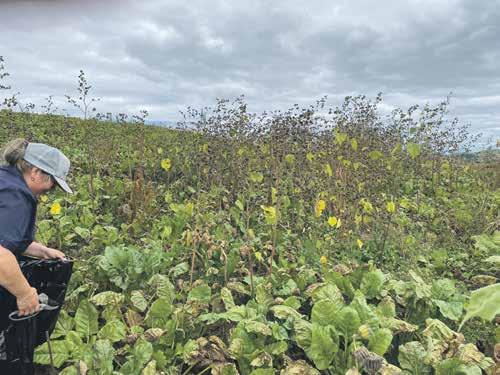
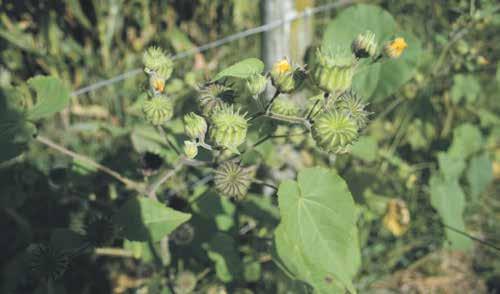
Five young New Zealanders have been selected for the Meat Industry Association scholarship programme for 2025.
The new scholars, undergraduate students from Dunedin, Blenheim, Milton, Cambridge and Opotiki, have joined the programme alongside 10 returning scholars. They are Georgia Te Raki, from Dunedin, Riley King, Blenheim, Katie Hollands, Cambridge, Nicole Petersen, Ōpōtiki and Zoe McElrea from Milton.

The association provides scholarships of $5000 a year for undergraduates and $10,000 for post-graduate students. All are tertiary students, studying a subject relevant to the red meat processing industry and planning a




career in the sector beyond the farm gate. Participants in this year’s new scholar intake are pursuing subjects including commerce, environmental science, law, agribusiness and food marketing and international agribusiness.
Association chief executive Sirma Karapeeva said the will be of great value in



future careers in the sector.
“In order to grow the sector, we need to continue to recruit ambitious and highly skilled people,” she said.
The scholars also benefit from the organisation’s mentoring programme and participation in a range of industry events and networking opportunities.

Sharefarmer Danielle Hovmand has a request for politicians – could they dial back the political ping-ponging?
The Federated Farmers Waikato sharemilker vice chair wouldn’t be working so hard to achieve her dream of farm ownership if she didn’t have faith in the future of dairy.
But she believes farmers – the younger ones struggling to achieve farm ownership in particular – want some longer-term policy stability on issues like land use restrictions, water quality and biodiversity.
“We’ve just seen a Labour Government leave, and we’ve swung to other extreme in terms of industry regulation.
“Will it just swing back again the next time the balance of power changes?”
Hovmand was recently crowned the New Zealand Young Farmers Contiki Local Legend, winning a $5000 Contiki voucher, in recognition of her work on fundraisers and a Foodbank drive.
She wants to see more effort go into building consensus that’s practical and affordable.
“I’m not a hugely political person but I do think we have to reduce this ping-ponging because it creates so much uncertainty.
“With agriculture being so vital to our economy, and with the ageing population at farm ownership level, the next generation need to be able to see a future in it.
“Even for those already farming, there can be a feeling of ‘I don’t want to do anything because a new regulation might come in that completely turns it around, and it turns out it was the wrong thing to do’.”
Hovmand, 28, was raised in Katikati and grew up on her grandparents’ Hereford stud farm nearby. By the time she finished school, she knew she wanted to be a farmer.
Holiday and summer jobs on a Katikati neighbour’s dairy farm in between gaining an agricultural science degree at Massey kicked off her dairy journey.
She moved to Waikato for better dairying prospects and contract milked for three years.
Last season she and her partner Harry Phipps, a builder in Te Aroha, purchased their first herd.
They’re now 50/50 sharemilkers, milking about 250 cows just north of Morrinsville.
“Our generation tends to think we’ve had it really hard, and with the financial climate it might be a bit harder.
“But it has always been difficult,” Hovmand says.
“Finding a business partner, going in with
parents, equity partnerships and the like are quite common now.
“We all just need to be more open to those different options to make it happen.”
Federated Farmers has a role there too, she says.
“One is education, such as the series of sharefarming workshops we held around the country recently.”
Hovmand is also pleased Federated Farmers’ advocacy spurred MP Suze Redmayne’s member’s bill that would allow someone to withdraw their KiwiSaver funds to buy a first farm.
It would also open the door for those living in service tenancies, such as farm staff, to use their KiwiSaver to buy their first home without having to live in it straight away.
“We just need the legislation to go that step further to allow KiwiSaver funds to be used for purchase of a first herd,” Hovmand says.
“By the time a younger farmer gets to the point of wanting to use their KiwiSaver to buy some land, they’ll probably have been putting money into it for quite a significant time.
“It could easily get them across the line a year or two earlier. I think it could be quite significant.”
Hovmand sees a need to combat negativity with accurate information and looking for solutions.
“I get asked ‘why should younger farmers join Federated Farmers?’.
“I tell them we are the future of the agriculture.
“We need to be sure that we’re involved in creating the kind of industry we want to be in.”
She recommends the Federated Farmers’ free ‘Young Farmers’ membership option.
“I joined the Morrinsville-Ngarua Young Farmers Club when I first moved to the Waikato.
“I lived quite a way of out of town. I didn’t know anyone and it was my way of meeting people.
“Being part of a community is big for me; I think that’s what makes you feel you belong.”
Hovmand met Harry through Young Farmers and it’s still a big part of their lives.
On the Federated Farmers Waikato leadership team, she presents a younger person’s view.
“I also try to gauge from other young farmers what’s concerning them, and what Federated Farmers could do to help them on their journey.
“I like to think it’s working out for both of us.”
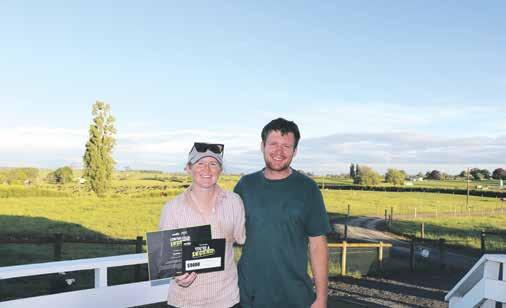
While it might not be easy to justify on a balance sheet, installing wool carpets in government buildings would provide invaluable support to New Zealand’s ailing wool industry.
After an earlier move to exclude wool as an option for flooring throughout its homes, Kāinga Ora recently re-opened its tender. This about-face has been welcomed by veteran King Country shearer, Digger Balme.
“It would show farmers that the government’s behind them and trying to help them as much as they can and it might put a little bit more money on the price per kilo for the wool,” he says. “It would be very disappointing if they don’t [choose wool].”
Although the move last year was intended to be ‘fiscally responsible’, it denied wool suppliers the opportunity to ‘put their best foot forward’, Minister of Housing, Chris Bishop, says.
“Although flooring choices for Kāinga Ora properties are operational decisions for the agency, I was disappointed to see woollen carpets ruled out unequivocally.
While it remains essential that Kāinga Ora delivers homes as cost-effectively as possible, it’s only fair that wool products are given the chance to compete for government contracts on an equal footing
with nylon carpet suppliers.” Minister of Agriculture, Mark Patterson, also supports the move.
“This is a great step toward ensuring wool, a sustainable and high-quality product, is given the fair consideration it deserves. It creates a level playing field [and] supports the wool industry,” he says.
“We encourage suppliers of wool carpets to consider participating in Kāinga Ora’s tender process.”
While it’s a little early for sheep farmers to celebrate, they certainly will, should wool be installed in Kāinga Ora homes as well as other government buildings.
Once widely favoured, wool has hit quite the snag, essentially becoming a cost rather than a revenue stream. It is also facing a new threat in recent years due to genetic research.
But this yarn isn’t over just yet, Balme adds.
“[The market] hasn’t been great, but it’s picked up in the last 12 months [at] over $3 a kilo. Hopefully, instead of it being a cost to farmers, they can break even or make a small profit on their wool,” he says.
“If we can sustain that price, at around $3 to $4 a kilo as a minimum, farmers will stay in the game and not so many will go for the shedding sheep.”
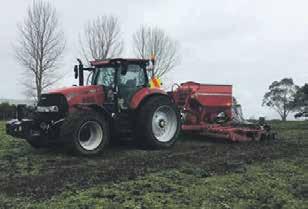

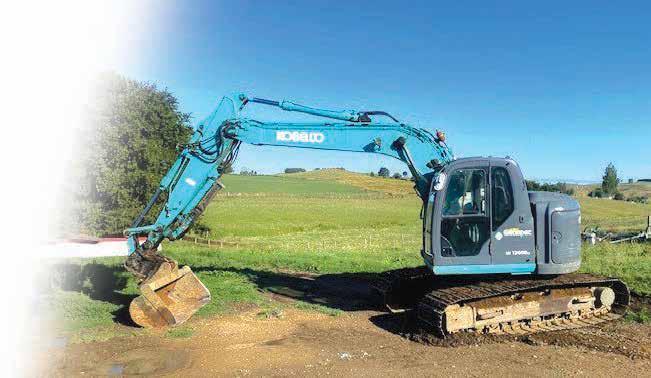


Experience the comfortable lifestyle and community atmosphere of a spacious new care studio in the heart of our retirement village. Rest home or continuing (hospital-level) care can be provided in the comfort of your studio. Meals, laundry, and cleaning are provided, and there is an enjoyable social programme, our buzzing village café, and convenient on-site shop.
Priced from $295,000* *
(ORA)
Across 1. Vessel (4) 4. Lubricate (6) 8. Good-natured (7) 9. Hesitate (5) 10. In pristine condition (4) 11. Foresee (8) 13. Beautiful and perfect (9) 17. Collect discarded material (8)
Last week
19. Snooze (4) 21. In the midst of (5) 22. Celebrate (7) 23. Pal (6) 24. Called (4)
Down
2. Crime (7) 3. Brass instrument (4) 4. Good in the garden (5-8)
5. Stated clearly, precisely (8) 6. Steam room (5) 7. Put off (5) 8. Military force (4) 12. Rubber scraper (8) 14. Feeling (7) 15. Customary (5) 16. Used to be (4) 18. Love (Fr) (5) 20. Slightly open (4)
Across: 1. Blank, 4. Inmate, 7. Awn, 8. Barber, 9. Single, 10. Advertisement, 14. Igloo, 15. Meter, 18. Underestimate, 23. Sketch, 24. Engine, 25. Own, 26. Addled, 27. Dryer.
Down: 1. Bland, 2. Amble, 3. Karate, 4. Insist, 5. Minim, 6. Talon, 10. Adieu, 11. Valid, 12. Extra, 13. Three, 16. Method, 17. Attend, 19. Naked, 20. Extol, 21. Muggy, 22. Tuner.
Advertising booking deadlines for Cambridge News, Te Awamutu News and King Country News is one week prior to publication day. Copy deadline for ad-make up is 5pm Friday prior to publication day. Advertiser is responsible to advise us of any copy changes before proofing deadline – anything not signed o by this time, ad prints as per the last proof sent. Advertising supplied in completed form (finished artwork or camera ready), deadline is Tuesday midday prior to publication day. Public holiday weeks, all deadlines move forward one working day. Cancellation deadline is one week prior to publication. If cancellations are received after the cancellation deadline, then full charge applies. All other publications and products see separate booking and deadline sheet. Advertising setting is free for up to two proofs, further changes will incur a production fee. Advertising copy set by Good Local Media Ltd is the property of Good Local Media Ltd and for use in Good Local Media Ltd publications only. If used elsewhere charges will apply, pricing available on request. If supplied ready to print, copy is owned by the advertiser. Publication day is Thursday for urban
CAQASRYRRAMANDATEV RTHIRRJCBANVSSOEMX DOLEEYPIAVMUOMRMEX MMMTAMOMENTMKVDAIF CESCDFMEADOWUALRPE IYPNMABNCFXEJMTTAP MTELLUMMUGODMALIGN IADLUOMMWNMNMNIAMH MEDICINEAMOIENPLJV MELTPLHMHANMREBMEM UYLABULYTDKSHQKSAM TQAARGEZOAETSUEPJP TYTIROJAMMYKLIMACE OHCRAMMTAMCTFNLKMG NMARQUISSEKBPJQRNJ
MACE MADAM MAIN MAJORITY MALIGN MALL MANDATE MANNEQUIN MANOEUVRE MANUKA MAP MARCH
MAROON MARQUIS MARTIAL MASK MATRIX MEADOW MEDAL MEDICINE MELT MEMBER MERRY MICROBE
deliveries and Friday morning for rural deliveries. Acceptance of advertising for publication and free productions services is at the discretion of the publisher.
RATE CARD: Rates are based on advertising space only and are over a 12-month period starting from the date the first ad publishes. Rate bracket e.g. 6 insertions, 12 insertions etc. chosen allows ad sizes to vary within the rate bracket. If the number of insertions chosen is not met then a bulk charge will be applied at the end/cancellation of your schedule based on correct rate reflective of the number of ads published e.g. if you have chosen the 12 insertion rate and only publish 6 insertions, the bulk charge will be the di erence in price between the 6 insertion rate and 12 insertion rate multiplied by the number of ads published. You pay the rate reflective of the number of ads you actually publish.
INVOICING AND PAYMENTS: For advertisers on a
MILKY MIMIC MIND MISREAD MOGUL MOHAIR MOMENT MONKEY MORAL MOSAIC
MOTH
MOTIF

MOULD MUESLI MUFFIN MUG MULLET MUTTON MYSTERY MYTH





Be wowed by this original Railway Cottage in Te Kuiti, one of the 1500 ever built in the country in the 1920’s.
A stunning well maintained three bedroom home with a new Colorsteel roof on a fully fenced section offers more than meets the eye. The nice open plan living/dining/kitchen area with its beautiful polished native floors, leads out onto the spacious covered deck, ideal for if you want to entertain large groups or simply enjoy family living outdoors. Underfloor and ceiling are insulated and the heat pump keeps you snug during the cooler months.


There is a separate laundry with an additional toilet in the outside room. The double garage with automatic door offers plenty of space for tools, toys and other storage. Located in walking distance to the CBD, schools, parks and transportation.
The large fridge/freezer is optional to purchase so is some of the furniture.
My motivated vendor has set her eyes on her new chapter and is ready to move on.
Call Antonia today to book a viewing or visit one of the open homes. ADDRESS 36 Te Kumi Road, Te Kuiti
3 bed, 1 bathroom, 2 toilets, 2 garage
$385,000
blueribbonharcourts.co.nz WEB ID OH22624
HOME Sunday 23 Feb, 12.00 - 12.30pm







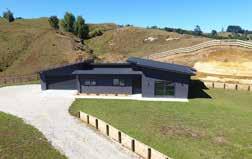







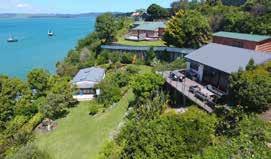







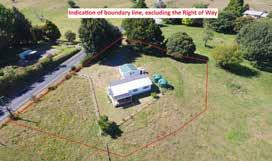
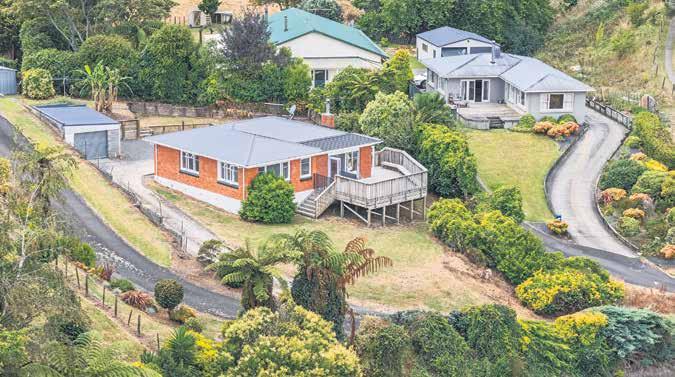
50's brick retro-charmer
Built in 1951, the 100 m2 home blends character with home comforts; stylish dark roller blinds, a composite matching carpet and toning vinyl, offset the neutral dove grey palette. This property is an excellent choice for a single person or a couple who are thinking about starting a family. An open-plan kitchen and dining area flow seamlessly into a light filled lounge/family room; offering plenty of space for everyday living. Bi-fold doors allow access from the lounge onto a large decked area creating an indoor-outdoor flow for entertaining and relaxing. An internal laundry adds to the home's practicality. Definitely a - must-see - for first-home buyers, and investors; with scope and potential to add value.





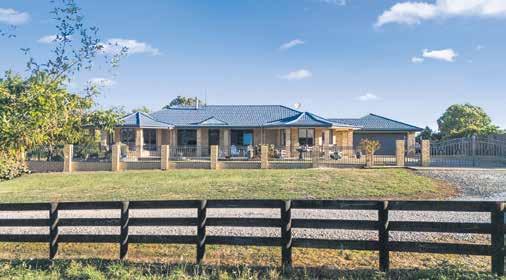













































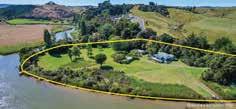













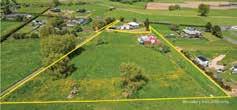

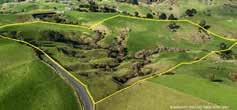

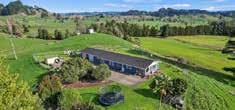













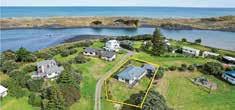













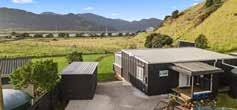







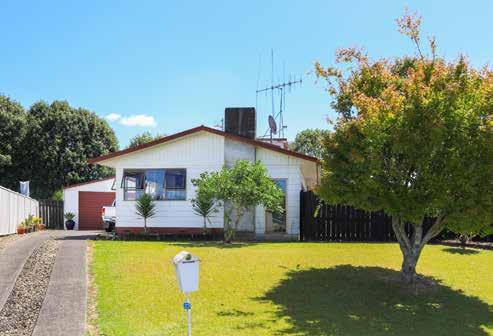

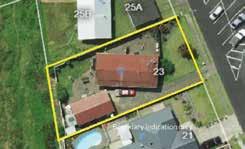


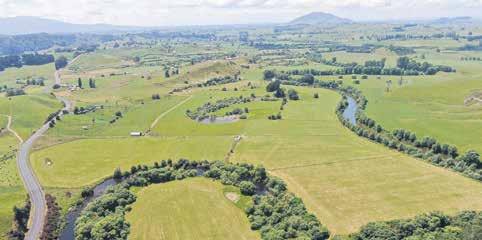

OTOROHANGA SHWY 31, Kawhia Road
29 Hectares Bare Flat Land
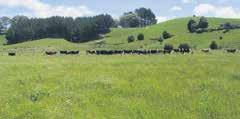
Very well-located bare property just 4km north of Otorohanga on State Highway 31 and borders the Waipa River. Current and past use is cattle finishing, silage and hay harvesting. It is nearly all flat land, with the exception being a slight hill. It is well fenced and laned. The water is ex bore and distributed throughout the farm. The vendor has leased nine hectares of neighbouring land. In 2023 they undersowed ten hectares. They wintered 82 R2 cattle. Supplements - 67 silage bales in January and December. 2022 - 221 silage bales and 82 hay bales. 2024 - 64 R2 Steers and 200 hay bales made.




























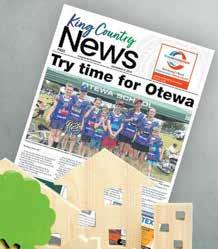


















































with Jan Bilton
Did you know? The average ear (cob) of sweetcorn has 800 kernels arranged in 16 rows.
Biologists believe that sweetcorn evolved from a wild grain called ‚teosinte’ that still grows in the Mexican Highlands. But it took thousands of years before the teosinte evolved from a grassy plant into the first corn cobs.
And when Christopher Columbus landed in Cuba in 1492, he reported that his men had discovered ‘a sort of grain called maiz’. This was the first time Europeans had heard of the plant we call corn.
Corn is a starchy vegetable like potatoes, but its kernels are considered grains and can be milled into flour. But it’s also technically a fruit because it comes from the seed or flower of a plant, similar to tomatoes. And like many fruits, due to its sugar content, corn can be turned into syrup as well.
Fresh sweetcorn is versatile and popular family fare. Sunripened, fresh young corn is luscious, even when eaten raw. Corn in the husk can be cooked in water, baked, barbecued or microwaved. Covering the corn while cooking keeps it moist and flavourful.
Sweetcorn is ready to pick when the fine tassels or silk at the ends are brown.
Spiced sweetcorn salad
2 large corn cobs
2 tablespoons canola oil
1 tablespoon yellow mustard seeds
1 teaspoon each: whole cumin seeds, fennel seeds pinch ground cinnamon
1/2 red capsicum, seeded and diced
1/2 cup each: diced cucumber, roasted peanuts
1 red chilli, diced
2-3 tablespoons chopped coriander leaves and stems 1/4 cup lemon juice
To remove the kernels from the cob, strip off the husks, stand the corn on its straight end, then run a sharp knife down between the kernels and the core.
Heat the oil in a non-stick pan on medium-low. Add the spices and cook until the mustard seeds start to pop, about
SPLIT FIREWOOD new season’s, shed stored, 3 cubic metres, $350 delivered Tkt/Oto area. Fresh sawdust $5 bag.
P 027 584 4505 or 07 894 5872.



30 seconds. Add the corn kernels and cook for 2-3 minutes, stirring occasionally. Add the red capsicum and continue cooking for another 3 minutes.
Remove from the heat. Add the cucumber, peanuts, chilli, coriander and lemon juice. Stir to combine. Serves 4 as a side dish.
Gluten-free corn fritters
1 large corn cob
3/4 cup chopped ham
2 spring onions, diced
1/2 small red capsicum, seeded and diced
4 tablespoons gluten-free self-raising flour
1 large egg, lightly beaten
3 tablespoons milk
2 tablespoons olive oil
To remove the kernels from the cob, strip off the husks, stand the corn on its straight end, then run a sharp knife down between the kernels and the core.
Place the corn kernels, ham, spring onions, GF flour, egg and milk in a medium bowl. Stir well.
Heat the oil in a large non-stick frying pan on medium. Add 1/4 cup measures of the fritter mixture in batches and panfry for 2-3 minutes each side, until golden and cooked through. Drain on paper towels. Great served with fresh fruit and a drizzle of maple syrup. Makes 8 fritters.
Corn with chilli n’ herb butter
These can be roasted in the oven, cooked in the microwave



This newspaper is subject to NZ Media Council procedures. A complaint must first be directed in writing, within one month of publication, to the editor’s email address.
If not satisfied with the response, the complaint may be referred to the Media Council P O Box 10-879, The Terrace, Wellington 6143. Or use the online complaint form at www. mediacouncil.org.nz
Please include copies of the article and all correspondence with the publication.

or barbecued.
Chilli n’ Herb Butter: 125g butter, softened 1/4 cup each: coriander leaves, flat-leaf parsley, finely chopped
1 long red chilli, seeded and diced
1 clove garlic, crushed pinch cayenne pepper, optional Corn: 6 sweetcorn cobs with husks
Combine the butter, herbs, chilli, garlic and cayenne pepper. Roll into a long log and wrap in plastic film. Freeze, until solid. Preheat the barbecue. Peel back the corn husks a little, remove the silk then close the husks back up. Place the cobs on a medium-heat barbecue for about 10 minutes, until sizzling. Turn often.
Remove from the grill. Carefully cut down the length of the husk with scissors or pull back and open out. Top with slices of the butter. Serve immediately. Serves 6.
Microwave corn cobs with basil butter
4 corn cobs with husks
Basil Butter: 50g butter, softened
4 tablespoons chopped fresh basil
2 tablespoons finely grated parmesan cheese freshly ground black pepper to taste
Discard any husks with imperfections.
To make the butter, beat all ingredients and spoon into a small ramekin.
To cook corn cobs in their husks place in the microwave oven and cook on high (100%) power for about 6 minutes. Serve with the butter. Serves 4.

Public notice is hereby given in accordance with the Hazardous Substances and New Organisms Act 1996 regulations that from 1 March 2025 or as soon as possible thereafter, sodium fluoroacetate (1080) impregnated baits will be applied by helicopter onto bush blocks in the Piopio East Priority Possum Control Area (PPCA). This operation is being conducted on behalf of Waikato Regional Council (160 Ward St, Hamilton) pursuant to section 114A of the Biosecurity Act 1993 to protect taonga species, biodiversity values, water quality and the integrity of partly forested stream catchments of the Mokau River.
The 1,720ha (approx.) operational area is located 3km east of Piopio, north of Mokauiti & west of State Highway 4 (refer to map).
Aerial Control Method
The first phase of the operation consists of the application of non-toxic cereal baits being applied by helicopter. The baits are cylindrical in shape and approximately 16mm in diameter, cinnamon lured and a light brown colour.
The second phase will follow approximately a week later (weather depending). Cereal baits containing the pesticide will be applied by helicopter. The pellets are cylindrical and approximately 20mm in diameter, dyed green and cinnamon lured.
All unauthorised entry into helipad areas is prohibited. Dogs should not have access or be taken into the operational area as they are particularly susceptible to 1080 and poisoned carcasses.
Poison warning signs will be erected at all points of public access and the public are reminded that it is an offence to remove any of these signs erected on land to which the poison has been applied.
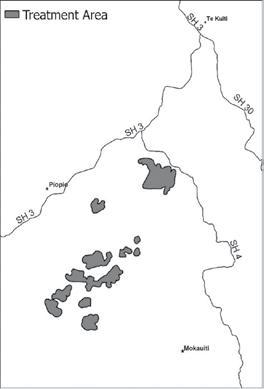
Always remember:
• DO NOT touch bait.
• WATCH children at all times.
DO NOT EAT animals from this area or within the buffer zone outside the treatment boundary. The buffer zone is 2 km for deer and pigs, 200 m for rabbits, and 1 km for hares, and possums.
Poison baits or carcasses are DEADLY to DOGS
Observe these rules whenever you see warning signs placed at public access ways in the above area.
Maps of the operational areas can be viewed during business hours at: EcoFX, Huiputea Drive, Otorohanga.
The operation will be under the control of the Aerial Operations Manager – Piopio East, EcoFX, PO Box 248, Otorohanga, telephone 07 873 8130.

Teacher Aide (part-time term time only) - 16 hours per week
Office Administrator (part-time term time only) - 8 hours per week
Cleaner (part-time term time only) - 4 hours per week
Note: these roles could be combined for the suitable candidate
For more information about these positions please see www.piripiri.school.nz/our-school/ our-staff/current-vacancies or contact principal@piripiri.school.nz
Please send your CV (including the details of at least 2 referees), and direct any enquiries to:
Matthew Jackson Piripiri School
2703 Te Anga Road, Te Kuiti principal@piripiri.school.nz 07 876 7522
• Customer focused and communityminded
• Reliable, motivated and flexible
• Enjoy working outdoors
We are looking for a reliable and motivated person to join our team to provide site operations at the Piopio Transfer Station. You will be the first point of contact for our customers, providing exceptional customer service and ensuring an effective solid waste management service is delivered. This is a permanent part time role, 3 days per week, 4 hours per day, including weekends.
To be successful in this role you will be:
• Customer-focused
• Motivated with a roll-your-sleeves up, can do attitude
• Physically fit to work outdoors
• Flexible and available to work weekends
• Health and Safety orientated
To apply for this position, please visit our recruitment website www.joinourteam.co.nz
Applications close:
3 March 2025


We are looking for a keen person to join our team in the kitchen. We can o er a minimum of 2 full days per week 10am - 9pm (approx). Experience preferred, but full training given to right candidate. Must be reliable and able to work in a fast paced environment.
Open 7 days serving lunch/dinner. If you are interested, email andy@stokedeatery.co.nz or call/message 021 136 3118.
Trades & Services
Property maintenance and construction
Lawns, trees, stump grinding, sections, moss & mould treatments, Chemwash, waterblasting, gutter vac, water tank and trough cleaning fences, retaining, odd jobs and more. References available GST registered.
Mike & Allana 027 350 0836 info@handy-man.co.nz
Painting interior/exterior
Exterior house washing
Small jobs welcome
Contact Steve 022 676 1839
No obligation free quotes
• Emptying septic tanks
• CCTV pipeline inspection
• Jetting drainage pipelines
• Spreading animal effluent
Waitomo Liquid Waste Disposal 021 111 3911


949 Rangitoto Road Tuesday, February 25 3.30-6.30pm
Prospective Parents - You are invited to come and see what makes Rangitoto School a fantastic place to learn and grow! Swimming pool will also be open.
We have small classes, dedicated teachers, beautiful grounds and a free school bus from Te Kūiti.
Any queries phone 07 878 8460 or email office@rangi.school.nz


A newspaper is more than just news. It involves you in the community with personal stories, thoughts, viewpoints, humour and helpful tips.
Your newspaper is a one-stop source for analysis, opinion, great writing and personality.
Nothing else is so focused on community. When buyers and sellers need to connect…

In accordance with the Tenth Schedule of the Local Government Act 1974, notice is hereby given that the Ōtorohanga District Council, for the purpose of holding the Ngutunui Sealed Rally Hill Climb, proposes to close the following road to ordinary vehicular traffic for the period indicated hereunder:
• Pekanui Rd - from Ngutuniui Rd to Okupata Rd
•Scott Rd
Period of Closures: 7.30am to 4 pm
There will not be a detour in place.
Access for emergency vehicles will be allowed in the event of an emergency.
Pursuant to the Transport (Vehicular Traffic Road Closure) Regulations 1965, any person objecting to the proposal is called upon to lodge notice of their objection and grounds thereof in writing before 5pm Thursday, February 27, 2025 at the offices of the Otorohanga District Council, 17 Maniapoto Street, Ōtorohanga.
Waikato Regional Council advises that under Resource Consent 124871 spraying of pest plants growing in aquatic and semi-aquatic locations will continue over the next three months.
Pest plants to be sprayed are listed in the Regional Pest Management Plan and include (but are not limited to): alligator weed, Manchurian wild rice, sagittaria, Senegal tea, spartina and yellow flag iris. Herbicides to be used are haloxyfop, imazapyr, metsulfuron-methyl and triclopyr. Application method is location dependent and may be by helicopter, gun and hose, mistblower or knapsack.
Operational areas are spread throughout the region and include (but are not limited to):
• Lakes Whangape and Waikare
• Te Otamanui Lagoon
• Waihou, Piako and Ohinemuri rivers
• Waikato River (from Horotiu to Port Waikato)
• Whangamarino and Maramarua rivers
• numerous smaller urban and rural sites.
Spraying is weather dependent and will occur during daylight hours on any day, including weekends but excluding public holidays.
For more information or to request to be notified visit www.waikatoregion.govt.nz/aquaticspraying or call Waikato Regional Council’s biosecurity pest plants team on 0800 800 401.
Occupiers who have already requested to be notified will be contacted prior to spraying.
CDA McLay Chief Executive
www.waikatoregion.govt.nz













Ask our friendly receptionists when you place your advert

Wednesday, March 5, 2025 @ 7pm at clubrooms
Ōtorohanga Sports Club, Orahiri Tce, Ōtorohanga
Agenda: Chairpersons welcome
Sunday 9th
March
Following the Morning Service.
Pirongia
This is a friendly reminder that the third instalment of your 2024/2025 rates is due by 5pm, Friday 28 February 2025. Rates invoices were posted out in January. Payments received after 5pm, 28 February will attract a 10% penalty.
Rates payments can be made at the Customer Service Centre, 160 Rora Street, Te Kūiti, over the phone by credit card, on our website or by Internet Banking using your valuation number as your reference.
Please contact our friendly Customer Services Team on 0800 932 4357 for further assistance.
Ben Smit Chief Executive
www.waitomo.govt.nz


Reach a targeted rural and lifestyle audience each month. Book your advert in the King Country Farmer.
Next Publication Date Thursday 20 March
Deadlines
Booking Wednesday 12 March
Copy Setting Thursday 13 March
Finished artwork Monday 17 March
To



WORLD DAY OF PRAYER

This year for the Cook Islands
Please join us on Friday, March 7 10am
Journey Church22 10 Sheridan St, Te Kūiti All welcome
YUM THAI LIMITED has made application to the District Licensing Committee at Ōtorohanga District Council, Ōtorohanga for the grant of an on license in respect of the premises situated at 81 Maniapoto St, Ōtorohanga known as Jasmines Thai Restaurant. The general nature of the of the business conducted (or to be conducted) under the license is a restaurant. The days on which and the hours during which alcohol (or intended to be). sold under the license are Monday to Sunday 11am to 12 midnight. The application may be inspected during ordinary office hours at the office of the Ōtorohanga District Licensing Committee, Ōtorohanga District Council, Maniapoto St, Ōtorohanga. Any person who is entitled to object and who wishes to object to the issue of the licence may, not later than 25 working days after publication of this notice, file a notice in writing of the objection with the District Licensing Committee at Ōtorohanga District council, PO Box11, Ōtorohanga 3940. No objection to the issue of a licence may be made in relation to a matter other than a matter specified in section 105 (1) of the Sale and Supply of Alcohol Act 2012. No objection to the issue of a licence may be made in relation to a matter other than a matter specified in section 131 of the Sale and Supply of Alcohol Act 2012. This is the first publication of this notice.


Application forms for individuals and organization’s may be printed off the Piopio website or by emailing the Trust. Email: piopiotrust@gmail.com
Areas covered for grants include Piopio Township and the districts of Mairoa –Mangaotaki – Mahoenui – Aria – Mokauiti – Mapiu – Kopaki – Benneydale –Oparure and Rangitoto. Te Kuiti Borough is not included.
Applications close at 5pm on March 31, 2025. Late applications will not be accepted.





























